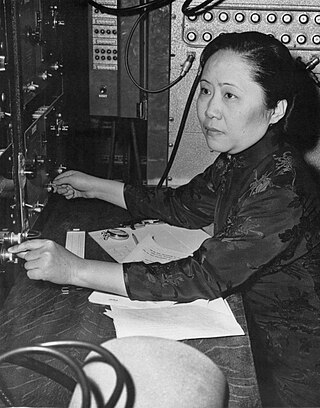Top Qs
Timeline
Chat
Perspective
List of nominees for the Nobel Prize in Physics
From Wikipedia, the free encyclopedia
Remove ads
The Nobel Prize in Physics (Swedish: Nobelpriset i fysik) is awarded annually by the Royal Swedish Academy of Sciences to scientists who have made outstanding contributions in Physics.[1] It is one of the five Nobel Prizes which were established by the will of Alfred Nobel in 1895.[2]

Every year, the Royal Swedish Academy of Sciences sends out forms, which amount to a personal and exclusive invitation, to about three thousand selected individuals to invite them to submit nominations. The names of the nominees are never publicly announced, and neither are they told that they have been considered for the Prize. Nomination records are strictly sealed for fifty years. As of 2025[update], the nominations for the years 1901 to 1974 are publicly available. Despite the annual sending of invitations, the prize was not awarded in six years (1916, 1931, 1934, 1940–1942) and have been delayed for a year nine times (1914, 1917, 1918, 1921, 1924, 1925, 1928, 1932, 1943).
From 1901 to 1974, 672 scientists were nominated for the prize, 100 of which were awarded either jointly or individually. 30 more scientists from these nominees were awarded after 1974. Of the 13 women nominees, only two were awarded the prize in physics. The first woman to be nominated was Marie Curie in 1902 by German scientist Emil Warburg and French mathematician Gaston Darboux, and she won the prize the next year. She is the only woman to win a Nobel Prize twice: Physics (1903) and Chemistry (1911).[3] Besides 27 and 3 scientists from these nominees won the prizes in Chemistry (including two more women) and in Physiology or Medicine correspondingly (including years after 1974). Only one informal corporation and one organization have been nominated: the Nuclear scientists (1946 and 1947) and CERN (1970).
Despite the long list of nominated noteworthy physicists, astronomers, engineers, and chemists, there have been other famed scientists who were overlooked for the prize in physics, such as physicists G.Fr.FitzGerald, G.Stokes, J.W.Gibbs, P.Drude, H.Minkowski, W.Ritz, G.J.Stoney, Osb.Reynolds, Fr.C.Alw.Pockels, V.Schumann, N.Umov, Ernst Pringsheim Sr., M.Smoluchowski, W.Voigt, M.Abraham, Al.Friedmann, G.Wulff, Ant. van den Broek, F.Kurlbaum, G.Sagnac, Em.Wiechert, R.Pictet, P.Ehrenfest, P.Knipping, L.Shubnikov, M.P.Bronstein, Ett.Majorana, Edw.Hall, S.P.Schubin, D.S.Roschdestwenski, Ol.Lodge, J.Larmor, J.Ishiwara, N.Dm.Papaleksi, R.Ch.Tolman, A.H.Pfund, W. W. Hansen, H.Nagaoka, Y.Nishina, Ya.Frenkel, Th.Kaluza, J.Lennard-Jones, H.Weyl, Al.Proca, J. von Neumann, G.Mie, D.Hartree, Ad.Smekal, P. Pringsheim, H. von Halban, Fr.Houtermans, B.Podolsky, A.I.Alikhanov, Ern.Marsden and E.F.Gross; astronomers and astrophysicists: Ot.W.v.Struve and his grandson Otto Struve, P.J.C.Janssen, Ch.Aug.Young, S.Newcomb, G.V.Schiaparelli, W. Huggins, K.Schwarzschild, P.Lowell, W.de Sitter, brothers Edw.Ch. and W.H.Pickering, R.H.Fowler, G.W.Ritchey, J.Jeans, Gr.Shajn, Otto Schmidt, G.Adr.Tikhov, C.K.Seyfert and Dm.Dm.Maksutov; inventors and engineers: Al.St.Popov, B.Rosing, G.B.Pegram, Ig.Kurchatov and S.Korolev.
In addition, nominations of 10 scientists and two corporations more were declared invalid by the Nobel Committee.
Remove ads
Nominees by their first nomination
Summarize
Perspective
1901–1909
More information Picture, Name ...
| Picture | Name | Born | Died | Years Nominated | Notes |
|---|---|---|---|---|---|
| 1901 | |||||
 |
Wilhelm Röntgen | March 27, 1845 Lennep, German Confederation |
February 10, 1923 Munich, Germany |
1901 | Won the 1901 Nobel Prize in Physics “in recognition of the extraordinary services he has rendered by the discovery of the remarkable rays subsequently named after him” and nominated later for the Nobel Prize in Physiology or Medicine too[a][4] |
 |
Henri Becquerel | December 15, 1852 Paris, France |
August 25, 1908 Le Croisic, France |
1901, 1902, 1903 | Shared the 1903 Nobel Prize in Physics “in recognition of the extraordinary services he has rendered by his discovery of spontaneous radioactivity” with P. and M.Curie[5] |
 |
Philipp Lenard | June 7, 1862 Preßburg, Austria |
May 20, 1947 Messelhausen, Germany |
1901, 1902, 1903, 1904, 1905, 1924, 1925 |
Won the 1905 Nobel Prize in Physics “for his work on cathode rays”[6] |
 |
Gabriel Lippmann | August 16, 1845 Bonnevoie, German Confederation |
July 13, 1921 SS France, Atlantic Ocean |
1901, 1903, 1904, 1905, 1906, 1907, 1908 | Won the 1908 Nobel Prize in Physics “for his method of reproducing colours photographically based on the phenomenon of interference”[7] |
 |
Guglielmo Marconi | April 25, 1874 Bologna, Kingdom of Italy |
July 20, 1937 Rome, Kingdom of Italy |
1901, 1902, 1903, 1908, 1909, 1929, 1933 |
Shared the 1909 Nobel Prize in Physics with K.F.Braun[b][8] |
 |
Johannes Diderik van der Waals | November 23, 1837 Leiden, Netherlands |
March 8, 1923 Amsterdam, Netherlands |
1901, 1907, 1909, 1910 | Won the 1910 Nobel Prize in Physics “for his work on the equation of state for gases and liquids”[9] |
 |
Svante Arrhenius | February 19, 1859 Vik Castle, Sweden |
October 2, 1927 Stockholm, Sweden |
1901, 1902, 1903 | Won the 1903 Nobel Prize in Chemistry and nominated for the Nobel Prize in Physiology or Medicine too[c][10] |
 |
William Wallace Campbell | April 11, 1862 Hancock County, Ohio, United States |
June 14, 1938 San Francisco, United States |
1901 | [11] |
 |
Adolf Erik Nordenskiöld | November 18, 1832 Helsingfors, Grand Duchy of Finland |
August 12, 1901 Dalbyö, Sweden |
1901 | Nominated the only time by El. Sidenbladh [sv]. Died before the only chance to be rewarded[12] |
 |
Henry Augustus Rowland | November 27, 1848 Honesdale, Pennsylvania, United States |
April 16, 1901 Baltimore, United States |
1901[d] | H.Aug.Rowland died before the only chance to be rewarded Self-nominations |
 |
Robert Henry Thurston | October 25, 1839 Providence, Rhode Island, United States |
October 25, 1903 Ithaca, New York, United States | ||
 |
William Thomson, 1st Baron Kelvin |
June 26, 1824 Belfast, United Kingdom of Great Britain and Ireland |
December 17, 1907 Largs, United Kingdom |
1901, 1902, 1903, 1906, 1907 | [13] |
 |
Pieter Zeeman | May 25, 1865 Zonnemaire, Netherlands |
October 9, 1943 Amsterdam, Netherlands |
1901, 1902 | [14] Shared the 1902 Nobel Prize in Physics “in recognition of the extraordinary service they rendered by their researches into the influence of magnetism upon radiation phenomena” [15] |
| 1902 | |||||
 |
Hendrik Lorentz | July 18, 1853 Arnhem, Netherlands |
February 4, 1928 Haarlem, Netherlands |
1902, 1912, 1913, 1918, 1919, 1923[d] | |
 |
Pierre Curie | May 15, 1859 Paris, France |
April 19, 1906 Paris, France |
1902, 1903 | [16] Shared the 1903 Nobel Prize in Physics “in recognition of the extraordinary services they have rendered by their joint researches on the radiation phenomena discovered by Professor Henri Becquerel” with H.Becquerel M.Curie won the 1911 Nobel Prize in Chemistry too[17] |
 |
Marie Curie | November 7, 1867 Warsaw, Congress of Poland |
July 4, 1934 Passy, Haute-Savoie, France | ||
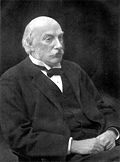 |
John William Strutt, 3rd Baron Rayleigh |
November 12, 1842 Langford Grove, Maldon, United Kingdom |
June 30, 1919 Terling Place, Witham, England |
1902, 1903, 1904, 1905[d] | Won the 1904 Nobel Prize in Physics “for his investigations of the densities of the most important gases and for his discovery of argon in connection with these studies”[18] |
 |
J. J. Thomson | December 18, 1856 Cheetham, United Kingdom |
August 30, 1940 Cambridge, England |
1902, 1904, 1905, 1906, 1907[d], 1912 |
Won the 1906 Nobel Prize in Physics “in recognition of the great merits of his theoretical and experimental investigations on the conduction of electricity by gases”[19] |
 |
Charles Édouard Guillaume | February 15, 1861 Fleurier, Switzerland |
May 13, 1938 Sèvres, France |
1902, 1903, 1904, 1908, 1910, 1912, 1913, 1914, 1920 | Won the 1920 Nobel Prize in Physics “in recognition of the service he has rendered to precision measurements in Physics by his discovery of anomalies in nickel steel alloys”[20] |
 |
Pierre Chappuis | Oktober 9, 1855 Bremblens, Switzerland |
February 15, 1916 Basel, Switzerland |
1902, 1903, 1904 | Nominated jointly with Ch.Éd.Guillaume and J.-M.-R.Benoît only by P.Kr.Prytz.[21] |
| Justin-Mirande René Benoit[22] | November 28, 1844 Montpellier, France |
May 4, 1922 Dijon, France |
1902, 1903, 1904, 1908, 1910, 1912, 1913, 1914, 1916 | [23] | |
 |
John Kerr | December 17, 1824 Ardrossan, United Kingdom |
August 15, 1907 Glasgow, Scotland |
1902, 1903 | [24] |
 |
Johann Wilhelm Hittorf | March 27, 1824 Bonn, German Confederation |
November 28, 1914 Münster, German Empire |
1902, 1903, 1904 | [25] |
| 1903 | |||||
 |
Gustave Le Bon | May 7, 1841 Nogent-le-Rotrou, France |
December 13, 1931 Marnes-la-Coquette, France |
1903 | Nominated the only time by Belgian physicist Pierre De Heen (1851–1915).[26] |
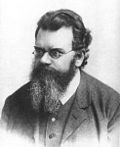 |
Ludwig Boltzmann | February 20, 1844 Vienna, Austria |
September 5, 1906 Tybein, Austria-Hungary |
1903, 1905, 1906 | [27] |
| 1904 | |||||
 |
Albert A. Michelson | December 19, 1852 Strzelno, Congress of Poland |
May 9, 1931 Pasadena, California, United States |
1904, 1907 | Won the 1907 Nobel Prize in Physics “for his optical precision instruments and the spectroscopic and metrological investigations carried out with their aid”[28] |
 |
William Ramsay | October 2, 1852 Glasgow, United Kingdom |
July 23, 1916 High Wycombe, United Kingdom |
1904, 1905[d] | Won the 1904 Nobel Prize in Chemistry[29] |
 |
Walter Kaufmann | June 5, 1871 Elberfeld, German Empire |
January 1, 1947 Freiburg im Breisgau, Germany |
1904 | Nominated jointly with J. J. Thomson, J.Dewar and K.Olszewski the only time by N.Umov.[30] |
| Ernst Abbe | January 23, 1840 Eisenach, German Confederation |
January 14, 1905 Jena, German Empire |
1904, 1905 | Nominated for the Nobel Prize in Physiology or Medicine too[e][31][32] | |
 |
Édouard Branly | November 23, 1844 Amiens, France |
March 24, 1940 Paris, France |
1904, 1909 | Nominated for the Nobel Prize in Chemistry too.[33] |
 |
Friedrich Kohlrausch | October 14, 1840 Rinteln, German Confederation |
January 17, 1910 Marburg, German Empire |
1904, 1905, 1906, 1907, 1908, 1909 | [34] |
| Julius Elster | December 24, 1854 Blankenburg (Harz), German Confederation |
April 6, 1920 Bad Harzburg, Germany |
1904, 1905, 1907, 1908, 1909, 1910, 1911 | [35] Only nominated jointly [36] | |
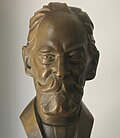 |
Hans Friedrich Geitel | July 16, 1855 Braunschweig, German Confederation |
August 15, 1923 Wolfenbüttel, Germany |
1904, 1905, 1907, 1908, 1909, 1910, 1911 | |
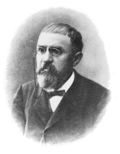 |
Henri Poincaré | April 29, 1854 Nancy, France |
July 17, 1912 Paris, France |
1904, 1906, 1907, 1909, 1910, 1911, 1912 | [37] |
 |
James Dewar | September 20, 1842 Kincardine, Fife, United Kingdom |
March 27, 1923 London, United Kingdom |
1904, 1905, 1912, 1913 | Nominated for the Nobel Prize in Chemistry too.[38] |
 |
Karol Olszewski | January 29, 1846 Broniszów, Podkarpackie Voivodeship, now Poland |
March 24, 1915 Kraków, now Poland |
1904, 1913 | Nominated for the Nobel Prize in Chemistry too.[39] |
 |
Oliver Heaviside | May 18, 1850 Camden Town, United Kingdom |
February 3, 1925 Torquay, England |
1904, 1905, 1907, 1909, 1911, 1912, 1914 | Nominated by V.Bjerknes only.[40] |
 |
Arthur Schuster | September 12, 1851 Frankfurt am Main, German Confederation |
October 14, 1934 Yeldall Manor, Berkshire, United Kingdom |
1904, 1914, 1917, 1925 | [41] |
| 1905 | |||||
 |
Karl Ferdinand Braun | June 6, 1850 Fulda, German Confederation |
April 20, 1918 Brooklyn, New York, United States |
1905, 1906, 1907, 1909 | Shared the 1909 Nobel Prize in Physics with G.Marconi[b][42] |
 |
Prosper-René Blondlot | July 3, 1849 Nancy, France |
November 24, 1930 Nancy, France |
1905 | Nominated the only time by Ch.J.Bouchard.[43] |
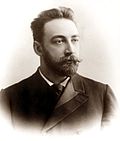 |
Pyotr Lebedev | February 24, 1866 Moscow, Russian Empire |
March 1, 1912 Moscow, Russian Empire |
1905, 1912 | [44] |
 |
Heinrich Kayser | March 16, 1853 Bingen am Rhein, German Confederation |
October 14, 1940 Bonn, Germany |
1905, 1916, 1917 | [45] |
 |
Augusto Righi | August 27, 1850 Bologna, Papal States |
June 8, 1920 Bologna, Kingdom of Italy |
1905, 1906, 1907, 1908, 1909, 1910, 1911, 1912, 1913, 1914, 1915, 1916, 1917, 1918, 1919, 1920 | [46] |
| 1906 | |||||
 |
Julius von Hann | March 23, 1839 Wartberg ob der Aist, Austria |
October 1, 1921 Vienna, Austria |
1906, 1911, 1913 | [47] |
| 1907 | |||||
 |
Wilhelm Wien | January 13, 1864 Gaffken near Fischhausen, German Confederation |
August 30, 1928 Munich, Germany |
1907, 1908, 1909, 1910, 1911, 1926, 1927, 1929 |
Won the 1911 Nobel Prize in Physics “for his discoveries regarding the laws governing the radiation of heat”[48] |
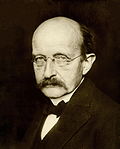 |
Max Planck | April 23, 1858 Kiel, German Confederation |
October 4, 1947 Göttingen, Germany |
1907, 1908, 1909, 1910, 1911, 1912, 1913, 1914, 1915, 1916, 1917, 1918, 1919, 1920[d] | Won the 1918 Nobel Prize in Physics in 1919 “in recognition of the services he rendered to the advancement of Physics by his discovery of energy quanta”[49] |
 |
Ernest Rutherford | August 30, 1871 Brightwater, British Empire |
October 19, 1937 Cambridge, United Kingdom |
1907, 1908, 1909[d], 1922, 1923, 1924, 1931, 1932, 1933, 1935, 1937 |
Won the 1908 Nobel Prize in Chemistry.[50] |
| Ernst Bessel Hagen | January 31, 1851 Königsberg, Kingdom of Prussia |
January 15, 1923 Munich, Germany |
1907 | Nominated jointly with H.Rubens the only time by G.H.Quincke.[51] | |
| Heinrich Rubens | March 30, 1865 Wiesbaden, German Confederation |
July 17, 1922 Berlin, Germany |
1907, 1909 | [52] | |
 |
Pierre Duhem | June 9, 1861 Paris, France |
September 14, 1916 Cabrespine, France |
1907, 1916 | [53] |
 |
William Crookes | June 17, 1832 London, United Kingdom |
April 4, 1919 London, England |
1907, 1910, 1911, 1914, 1918 | Nominated for the Nobel Prize in Chemistry too.[54] |
| 1908 | |||||
 |
Gustaf de Laval | May 9, 1845 Orsa Municipality, Sweden |
February 2, 1913 Stockholm, Sweden |
1908 | Nominated for the Nobel Prize in Chemistry too by Sven Otto Pettersson [sv] only[55] |
 |
Joseph Norman Lockyer[d] | May 17, 1836 Rugby, Warwickshire, United Kingdom |
August 16, 1920 Salcombe Regis, England |
1908, 1909 | |
 |
Émile Amagat | January 2, 1841 Saint-Satur, France |
February 15, 1915 Saint-Satur, France |
1908, 1913, 1914 | [56] |
| 1909 | |||||
 |
Heike Kamerlingh Onnes | September 21, 1853 Groningen, Netherlands |
February 21, 1926 Leiden, Netherlands |
1909, 1910, 1912, 1913, 1914[d] | Won the 1913 Nobel Prize in Physics “for his investigations on the properties of matter at low temperatures which led, inter alia, to the production of liquid helium” and nominated for the Nobel Prize in Chemistry too.[57] |
 |
Henri Farman | May 26, 1874 Paris, France |
July 17, 1958 Paris, France |
1909 | [58] Nominated jointly with brothers Wright only [59] |
 |
Gabriel Voisin | February 5, 1880 Belleville, France |
December 25, 1973 Ozenay, France | ||
 |
Orville Wright | August 19, 1871 Dayton, United States |
January 30, 1948 Dayton, United States |
1909, 1913 | [60] Only nominated jointly [61] |
 |
Wilbur Wright | April 16, 1867 Millville, United States |
May 30, 1912 Dayton, United States | ||
 |
John Henry Poynting | September 9, 1852 Monton, United Kingdom |
March 30, 1914 Birmingham, England |
1909, 1911, 1912 | [62] |
 |
Valdemar Poulsen | November 23, 1869 Copenhagen, Denmark |
July 23, 1942 Gentofte, Denmark |
1909, 1916, 1917, 1918, 1919, 1920, 1921, 1922, 1923 | [63] |
 |
George Ellery Hale | June 29, 1868 Chicago, United States |
February 21, 1938 Pasadena, United States |
1909, 1913, 1914, 1915, 1916, 1917, 1922, 1923, 1924, 1925, 1934 | [64] |
Close
1910–1919
More information Picture, Name ...
| Picture | Name | Born | Died | Years Nominated | Notes |
|---|---|---|---|---|---|
| 1910 | |||||
 |
Albert Einstein | March 14, 1879 Ulm, German Empire |
April 18, 1955 Princeton, New Jersey, United States |
1910, 1912, 1913, 1914, 1916, 1917, 1918, 1919, 1920, 1921, 1922, 1923 | Won the 1921 Nobel Prize in Physics in 1922[f][65] |
 |
Allvar Gullstrand | June 5, 1862 Landskrona, Sweden |
July 28, 1930 Stockholm, Sweden |
1910, 1911, 1912 | Won the 1911 Nobel Prize in Physiology or Medicine.[66] |
 |
Knut Ångström | January 12, 1857 Uppsala parish [sv], Sweden |
March 4, 1910 Uppsala parish, Sweden |
1910 | Nominated the only time by W.Röntgen.[67] Died before the only chance to be rewarded. |
 |
Otto Lummer | July 17, 1860 Gera, German Confederation |
July 5, 1925 Breslau, now Poland |
1910, 1911 | Nominated jointly with W.Wien and M.Planck by Em.Warburg only.[68] |
 |
Henri Abraham | July 12, 1868 Paris, France |
December 22, 1943 Oświęcim, now Poland |
1910, 1916 | [69] |
 |
Paul Langevin | January 23, 1872 Paris, France |
December 19, 1946 Paris, France |
1910, 1916, 1921, 1922, 1925, 1927, 1928, 1929, 1930, 1931, 1932[d], 1933, 1934, 1935, 1937, 1946 | [70] |
| 1911 | |||||
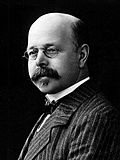 |
Walther Nernst | June 25, 1864 Briesen, now Poland |
November 18, 1941 Zibelle, now Poland |
1911, 1912, 1914, 1915, 1916, 1917, 1921 | Won the 1920 Nobel Prize in Chemistry in 1921.[71] |
 |
Ernst Mach | February 18, 1838 Brünn, now Czechia |
February 19, 1916 Munich, German Empire |
1911, 1912, 1914 | [72] |
 |
Loránd Eötvös | July 27, 1848 Buda, Hungary |
April 8, 1919 Budapest, Hungary |
1911, 1914, 1917, 1923[d] | [73] |
| Eugen Goldstein | September 5, 1850 Gleiwitz, now Poland |
December 25, 1930 Berlin, Germany |
1911, 1913, 1926 | [74] | |
 |
Charles Fabry | June 11, 1867 Marseille, France |
December 11, 1945 Paris, France |
1911, 1914, 1916, 1917, 1918, 1922, 1925, 1928[d], 1932 | [75] |
| 1912 | |||||
 |
Gustaf Dalén | November 30, 1869 Stenstorp, Sweden |
December 9, 1937 Lidingö, Sweden |
1912 | Won the 1912 Nobel Prize in Physics[g][76] |
 |
Robert Hadfield | November 28, 1858 Sheffield, United Kingdom |
September 30, 1940 Surrey, England |
1912, 1913 | [77] |
| 1913 | |||||
 |
Jean Baptiste Perrin | September 30, 1870 Lille, France |
April 17, 1942 New York City, United States |
1913, 1916, 1917, 1918, 1919, 1920, 1921, 1922, 1923, 1924, 1925, 1926 | Won the 1926 Nobel Prize in Physics[h] and nominated for the Nobel Prize in Chemistry too.[78] |
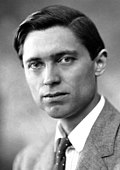 |
Theodor Svedberg | August 30, 1884 Fleräng, Sweden |
February 25, 1971 Kopparberg, Sweden |
1913, 1919 | Won the 1926 Nobel Prize in Chemistry.[79] |
| Hermann Frahm [de] | December 8, 1867 Büdelsdorf, North German Confederation |
December 28, 1939 Remscheid, Germany |
1913 | Nominated the only time by Sv.Arrhenius.[80] | |
 |
Adolf Slaby | April 18, 1849 Berlin, German Confederation |
April 6, 1913 Charlottenburg, German Empire |
1913 | Nominated the only time by Pehr af Bjerkén [sv].[81] Died before the only chance to be rewarded. |
 |
Ferdinand von Zeppelin | July 8, 1838 Konstanz, German Confederation |
March 8, 1917 Berlin, German Empire |
1913 | Nominated jointly with brothers Wrights the only time by V.Czerny.[82] |
| Henry Frederic William Burstall[d] | September 3, 1865 Old Machar, Aberdeenshire, United Kingdom |
July 15, 1934 Hopwood, Worcestershire, United Kingdom |
1913 | Self-nomination | |
 |
Hugh Longbourne Callendar | April 18, 1863 Hatherop, United Kingdom |
January 21, 1930 Ealing, England |
1913, 1918, 1921 | [83] |
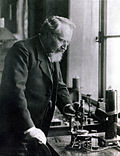 |
Otto Lehmann | January 13, 1855 Konstanz, German Confederation |
June 17, 1922 Karlsruhe, Germany |
1913, 1914, 1915, 1916, 1917, 1918, 1919, 1920, 1921, 1922 | Nominated by C.Benedicks only.[84] |
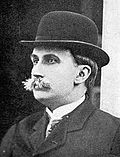 |
Henri-Alexandre Deslandres | July 24, 1853 Paris, France |
January 15, 1948 Paris, France |
1913, 1915, 1916, 1923 | [85] |
 |
Carl von Linde | June 11, 1842 Berndorf, German Confederation |
November 16, 1934 Munich, Germany |
1913, 1918, 1926 | [86] |
| 1914 – Prize has been awarded a year later | |||||
 |
Johannes Stark | April 15, 1874 Schickenhof, German Empire |
June 21, 1957 Traunstein, Germany |
1914, 1916, 1917, 1918, 1919 | Won the 1919 Nobel Prize in Physics[i][87] |
 |
Henry Louis Le Chatelier | October 8, 1850 Paris, France |
September 17, 1936 Miribel-les-Échelles, France |
1914 | Nominated jointly with W.Nernst the only time by Sven Otto Pettersson [sv] and for the Nobel Prize in Chemistry too.[88] |
 |
Louis Georges Gouy | February 19, 1854 Vals-les-Bains, France |
January 27, 1926 Vals-les-Bains, France |
1914, 1916, 1917, 1918, 1919, 1922 | [89] |
 |
Friedrich Paschen | January 22, 1865 Schwerin, German Confederation |
February 25, 1947 Potsdam, Germany |
1914, 1915, 1918, 1919, 1922, 1923, 1924, 1925, 1926, 1927, 1928, 1929, 1930, 1931, 1932, 1933 | [90] |
| Martin Knudsen | February 15, 1871 Hasmark [da], Denmark |
May 27, 1949 Gentofte, Denmark |
1914, 1916, 1917, 1918, 1919, 1920, 1921, 1937 | [91] | |
 |
Robert W. Wood | May 2, 1868 Concord, Massachusetts, United States |
August 11, 1955 Amityville, New York, United States |
1914, 1915, 1920, 1924, 1925, 1926, 1927, 1928, 1929, 1930, 1931, 1932, 1933, 1937, 1942, 1950 | [92] |
 |
Max von Laue | October 9, 1879 Pfaffendorf, German Empire |
April 24, 1960 West Berlin, Germany |
1914, 1915 | Won the 1914 Nobel Prize in Physics in 1915[j][93] |
 |
William Henry Bragg | July 2, 1862 Wigton, United Kingdom |
March 12, 1942 London, England |
1914, 1915 | W.H.Bragg nominated for the Nobel Prize in Chemistry too[94] Shared the 1915 Nobel Prize in Physics[k] .[95] |
| 1915 | |||||
 |
Lawrence Bragg | March 31, 1890 Adelaide, Australia |
July 1, 1971 Waldringfield, United Kingdom |
1915 | |
 |
Charles Galton Darwin | December 18, 1887 Cambridge, United Kingdom |
December 31, 1962 Cambridge, England |
1915 | [96] Nominated jointly with W.H.Bragg the only time by Sv.Arrhenius and for the Nobel Prize in Chemistry too. Moseley has been killed before the only chance to be rewarded.[97] |
 |
Henry Moseley | November 23, 1887 Weymouth, Dorset, United Kingdom |
August 10, 1915 Gallipoli campaign, Turkey | ||
 |
Charles Thomson Rees Wilson | February 14, 1869 Glencorse, United Kingdom |
November 15, 1959 Carlops, Scotland |
1915, 1918, 1924, 1925, 1926, 1927 | Shared the 1927 Nobel Prize in Physics[l] with A.Compton[98] |
 |
Thomas Edison | February 11, 1847 Milan, Ohio, United States |
October 18, 1931 West Orange, New Jersey, United States |
1915 | Nominated the only time by H.F.Osborn.[99] |
| Giacomo Casalis | 1869 Italy |
after 1931 | 1915 | [100] Nominated jointly[101] the only time by T.Boggio [102] | |
| Nicola Pavia[103] | 1872 Torino, Kingdom of Italy |
February 22, 1937 Torino, Kingdom of Italy | |||
 |
Kristian Birkeland | December 13, 1867 Christiania, Norway |
June 15, 1917 Tokyo, Japan |
1915, 1916, 1917 | Nominated jointly with C.Størmer only and for the Nobel Prize in Chemistry too.[104] |
 |
Carl Størmer | September 3, 1874 Skien, Norway |
August 13, 1957 Oslo, Norway |
1915, 1916, 1917, 1925, 1927, 1934 | [105] |
 |
Aimé Cotton | October 9, 1869 Bourg-en-Bresse, France |
April 16, 1951 Sèvres, France |
1915, 1916, 1920, 1922, 1925, 1927, 1928, 1929, 1930, 1931, 1932, 1933, 1934, 1944, 1949 | [106] |
| 1916 – this year Prize was not awarded | |||||
| Henri Mouton | September 5, 1869 Cambrai, France |
June 13, 1935 Bezons, France |
1916 | Nominated jointly with A.Cotton, L.G.Gouy, P.Duhem and Ch.Fabry the only time by M.Brillouin.[107] | |
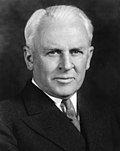 |
Robert Andrews Millikan | March 22, 1868 Morrison, Illinois, United States |
December 19, 1953 San Marino, California, United States |
1916, 1918, 1919, 1920, 1921, 1922, 1923, 1924[d], 1926 |
Won the 1923 Nobel Prize in Physics[m][108] |
 |
Irving Langmuir | January 31, 1881 Brooklyn, New York City, United States |
August 16, 1957 Woods Hole, Massachusetts, United States |
1916, 1928, 1929, 1933, 1940 |
Won the 1932 Nobel Prize in Chemistry.[109] |
 |
Peter Debye | March 24, 1884 Maastricht, Netherlands |
November 2, 1966 Ithaca, New York, United States |
1916, 1917, 1921, 1922, 1924, 1925, 1926, 1927, 1928, 1929, 1930, 1931, 1932, 1933, 1936, 1939 |
Won the 1936 Nobel Prize in Chemistry.[110] |
 |
Carl Runge | August 30, 1856 Bremen, German Confederation |
January 3, 1927 Göttingen, Germany |
1916, 1917 | Nominated jointly with H.Kayser only.[111] |
| Alexandre Dufour | May 8, 1875 Paris, France |
June 19, 1942 Paris, France |
1916 | Nominated jointly with H.Abraham and G.-A.Ferrié the only time by M.Brillouin.[112] | |
 |
Gustave-Auguste Ferrié | November 19, 1868 Saint-Michel-de-Maurienne, France |
February 16, 1932 Paris, France |
1916, 1930, 1931 | [113] |
| Peder Oluf Pedersen | June 19, 1874 Sig, Denmark |
August 30, 1941 Copenhagen, Denmark |
1916, 1917, 1918, 1919, 1920, 1921, 1922, 1923 | Nominated jointly with V.Poulsen only.[114] | |
 |
Pierre Weiss | March 25, 1865 Mulhouse, France |
October 24, 1940 Lyon, France |
1916, 1921, 1922, 1924, 1925, 1927[d], 1928, 1929, 1930, 1931, 1932, 1933, 1934, 1936, 1937 | [115] |
| 1917 – Prize has been awarded a year later | |||||
 |
Niels Bohr | October 7, 1885 Copenhagen, Denmark |
November 18, 1962 Copenhagen, Denmark |
1917, 1918, 1919, 1920, 1921, 1922, 1923[d] | Won the 1922 Nobel Prize in Physics[n] and nominated for the Nobel Prize in Chemistry too[116] |
 |
Johannes Rydberg | November 8, 1854 Halmstad, Sweden |
December 28, 1919 Lund, Sweden |
1917, 1920[d] | [117] |
 |
Arnold Sommerfeld | December 5, 1868 Königsberg, North German Confederation |
April 26, 1951 Munich, Germany |
1917, 1918, 1919, 1920, 1922, 1923, 1924, 1925, 1926, 1927, 1928, 1929, 1930, 1931, 1932, 1933, 1934, 1935, 1936, 1937, 1940, 1948, 1949, 1950, 1951 | [118] |
| 1918 – Prize has been awarded a year later | |||||
 |
Charles Glover Barkla | June 7, 1877 Widnes, United Kingdom |
October 23, 1944 Edinburgh, United Kingdom |
1918, 1919[d] | Won the 1917 Nobel Prize in Physics in 1918[o][119] |
 |
Alfred Perot | November 3, 1863 Metz, France |
November 28, 1925 Paris, France |
1918 | Nominated jointly with R.A.Millikan, H.L.Callendar and Th.Lyman IV the only time by H.Crew.[120] |
| Fernando Sanford | February 12, 1854 Franklin Grove, Illinois, United States |
May 21, 1948 Santa Clara, California, United States |
1918, 1919, 1920 | Nominated by D.St.Jordan only.[121] | |
| Theodore Lyman IV | November 23, 1874 Boston, Massachusetts, United States |
October 11, 1954 Cambridge, Massachusetts, United States |
1918, 1926 | Nominated jointly with R.A.Millikan only.[122] | |
| 1919 | |||||
 |
Percy Williams Bridgman | April 21, 1882 Cambridge, Massachusetts, United States |
August 20, 1961 Randolph, New Hampshire, United States |
1919, 1924, 1928, 1929, 1933, 1934, 1936, 1939, 1940, 1941, 1942, 1943, 1945, 1946 | Won the 1946 Nobel Prize in Physics[p] and nominated for the Nobel Prize in Chemistry too.[123] |
Close
1920–1930
More information Picture, Name ...
| Picture | Name | Born | Died | Years Nominated | Notes |
|---|---|---|---|---|---|
| 1920 | |||||
 |
Friedrich Wilhelm Ostwald | September 2, 1853 Riga, Russian Empire |
April 4, 1932 Großbothen, Germany |
1920, 1921, 1923, 1924 | Won the 1909 Nobel Prize in Chemistry[124] and self-nominated for the Nobel Prize in Physics[d] |
 |
Walter Sydney Adams | December 20, 1876 Antakya, Turkey |
May 11, 1956 Pasadena, California, United States |
1920 | Nominated the only time by Alfred Fowler.[125] |
 |
Carl Barus | February 19, 1856 Cincinnati, United States |
September 20, 1935 Providence, Rhode Island, United States |
1920, 1921 | [126] |
 |
Louis Lumière | October 5, 1864 Besançon, France |
June 6, 1948 Bandol, France |
1920, 1921, 1922, 1924, 1927 | Nominated jointly with A.Lumière by H.L.Le Chatelier only.[127] |
 |
Auguste Lumière | October 19, 1862 Besançon, France |
April 10, 1954 Lyon, France |
Nominated for the Nobel Prize in Physiology or Medicine too[q][128][129] | |
| 1921 – Prize has been awarded a year later | |||||
| Ernst Gehrcke | July 1, 1878 Berlin, German Empire |
January 25, 1960 Hohen Neuendorf, Germany |
1921, 1923, 1924, 1928 | [130] | |
 |
Abbott Lawrence Rotch | January 6, 1861 Boston, United States |
April 7, 1912 Boston, United States |
1921[d] | Nominated posthumously with V.Fr.K.Bjerknes and W.N.Shaw by Al.G.McAdie the only time |
 |
Léon Teisserenc de Bort | November 5, 1855 Paris, France |
January 2, 1913 Cannes, France | ||
| 1922 | |||||
 |
Francis William Aston | September 1, 1877 Harborne, United Kingdom |
November 20, 1945 Cambridge, England |
1922 | Won the 1922 Nobel Prize in Chemistry.[131] |
 |
Charles Greeley Abbot | May 31, 1872 Wilton, New Hampshire, United States |
December 17, 1973 Riverdale Park, Maryland, United States |
1922 | Nominated jointly with Fr.W.Aston, R.A.Millikan, W.D.Coolidge and G.Ell.Hale the only time by Ch.D.Walcott.[132] |
 |
Leo Graetz | September 26, 1856 Breslau, now Poland |
November 12, 1941 Munich, Germany |
1922, 1924 | Nominated by G. von Mayr [de] only.[133] |
| William D. Coolidge | October 23, 1873 Hudson, Massachusetts, United States |
February 3, 1975 Schenectady, New York, United States |
1922, 1927, 1935 | [134] | |
| 1923 | |||||
 |
Frederick Soddy | September 2, 1877 Eastbourne, United Kingdom |
September 22, 1956 Brighton, England |
1923 | Won the 1921 Nobel Prize in Chemistry in 1922.[135] |
 |
Kazimierz Fajans | May 27, 1887 Warsaw, Congress of Poland |
May 18, 1975 Michigan, United States |
1923 | Nominated with Fr.Soddy by Em.G.Warburg and for the Nobel Prize in Chemistry too[136] |
| Notgemeinschaft der Deutschen Wissenschaft | October 30, 1920 |
1923[d] | Nominated for the Nobel Prize in Chemistry too by Sv.Aug.Arrhenius only | ||
| Wolfgang Gaede | May 25, 1878 Bremerhaven, German Empire |
June 24, 1945 Munich, Germany |
1923, 1924, 1925, 1929, 1935, 1936, 1937 | [137] | |
 |
Vilhelm Bjerknes | March 14, 1862 Christiania, Norway |
April 9, 1951 Oslo, Norway |
1921[d], 1923, 1924, 1926, 1929, 1936, 1937, 1938, 1939, 1940, 1942, 1944, 1945 | [138] |
 |
James Franck | August 26, 1882 Hamburg, German Empire |
May 21, 1964 Göttingen, Germany |
1923, 1924, 1925, 1926 | [139] Shared the 1925 Nobel Prize in Physics in 1926[r] [140] |
| 1924 – Prize has been awarded a year later | |||||
 |
Gustav Ludwig Hertz | July 22, 1887 Hamburg, German Empire |
October 30, 1975 East Berlin, Germany |
1924, 1926 | |
 |
Owen Willans Richardson | April 26, 1879 Dewsbury, United Kingdom |
February 15, 1959 Alton, Hampshire, England |
1924, 1925, 1926, 1927, 1928, 1929 | Won the 1928 Nobel Prize in Physics in 1929[s][141] |
| Jules Richard | 1862[t] France |
1924 | Nominated the only time by prominent meteorologist and climatologist Alfred Angot [fr].[142] | ||
 |
Napier Shaw | March 4, 1854 Birmingham, United Kingdom |
March 23, 1945 London, England |
1921[d], 1924, 1927 | Nominated by Al.G.McAdie only.[143] |
 |
John Sealy Townsend | June 7, 1868 Galway, United Kingdom of Great Britain and Ireland |
February 16, 1957 Oxford, United Kingdom |
1924, 1942, 1944 | [144] |
| 1925 | |||||
 |
Manne Siegbahn | December 3, 1886 Örebro, Sweden |
September 26, 1978 Stockholm, Sweden |
1923[d], 1925 | Won the 1924 Nobel Prize in Physics in 1925[u][145] |
 |
Arthur Compton | September 10, 1892 Wooster, Ohio, United States |
March 15, 1962 Berkeley, California, United States |
1925, 1926, 1927, 1928[d] | Shared the 1927 Nobel Prize in Physics[v] with Ch.Th.R.Wilson[146] |
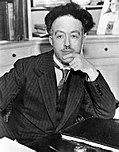 |
Louis de Broglie | August 15, 1892 Dieppe, France |
March 19, 1987 Louveciennes, France |
1925, 1926, 1928, 1929, 1950 |
Won the 1929 Nobel Prize in Physics[w][147] |
 |
Otto Stern | February 17, 1888 Sohrau, now Poland |
August 17, 1969 Berkeley, California, United States |
1925, 1927, 1928, 1929, 1930, 1931, 1932, 1933, 1934, 1935, 1936, 1937, 1938, 1939, 1940, 1941, 1943, 1944, 1945 | Won the 1943 Nobel Prize in Physics in 1944[x][148] |
 |
Walther Gerlach | August 1, 1889 Biebrich, German Empire |
August 10, 1979 Munich, Germany |
1925, 1927, 1928, 1929, 1930, 1931, 1932, 1934, 1936, 1937, 1940, 1944 | Nominated jointly with Otto Stern only.[149] |
| Siegmund Strauss [de] | January 4, 1875 Znaim, now Czechia |
March 29, 1942 New York City, United States |
1925 | Nominated the only time by F.Ehrenhaft.[150] | |
 |
John Ambrose Fleming | November 29, 1849 Lancaster, Lancashire, United Kingdom |
April 18, 1945 Sidmouth, England |
1925, 1927, 1928, 1934 | [151] |
 |
Maurice de Broglie | April 27, 1875 Paris, France |
July 14, 1960 Neuilly-sur-Seine, France |
1925, 1926, 1928, 1930[d], 1939, 1946 | [152] |
| 1926 | |||||
 |
Dayton Miller | March 13, 1866 Strongsville, Ohio, United States |
February 22, 1941 Cleveland, United States |
1926 | Nominated the only time by J.Sw.Ames.[153] |
| Werner Kolhörster | December 28, 1887 Schwiebus, Brandenburg, now Poland |
August 5, 1946 Munich, Germany |
1926, 1935[d] | Nominated jointly with E.Goldstein the only time by Ernst Gehrcke.[154] | |
| 1927 | |||||
 |
Viktor Kaplan | November 27, 1876 Mürzzuschlag, Austria-Hungary |
August 23, 1934 Unterach am Attersee, Austria |
1927 | Nominated the only time by Fr.Niethammer [de].[155] |
 |
Carl Ramsauer | February 6, 1879 Osternburg, Oldenburg, German Empire |
December 24, 1955 Berlin, Germany |
1927, 1931 | Nominated by R.W.Pohl only.[156] |
| 1928 – Prize has been awarded a year later | |||||
 |
Ludwig Prandtl | February 4, 1875 Freising, German Empire |
August 15, 1953 Göttingen, Germany |
1928, 1937 | [157] |
 |
Jacob Bjerknes | November 2, 1897 Stockholm, Sweden |
July 7, 1975 Los Angeles, United States |
1928, 1936, 1937, 1938, 1939 | [158] |
 |
Tor Bergeron | August 15, 1891 Godstone, United Kingdom |
June 13, 1977 Uppsala, Sweden |
1928, 1937, 1938, 1939 | [159] Nominated jointly with J.Bjerknes only [160] |
 |
Halvor Solberg | February 5, 1895 Ringsaker, Norway |
January 31, 1974 Oslo, Norway |
1928, 1937, 1938, 1939 | |
 |
Werner Heisenberg | December 5, 1901 Würzburg, German Empire |
February 1, 1976 Munich, Germany |
1928, 1929, 1930, 1931, 1932, 1933, 1969 |
Won the 1932 Nobel Prize in Physics in 1933[y][161] |
 |
Erwin Schrödinger | August 12, 1887 Vienna, Austria-Hungary |
January 4, 1961 Vienna, Austria |
1928, 1929, 1930, 1931, 1932, 1933 | [162] Shared the 1933 Nobel Prize in Physics[z] [163] |
| 1929 | |||||
 |
Paul Dirac | August 8, 1902 Bristol, United Kingdom |
October 20, 1984 Tallahassee, Florida, United States |
1929, 1933 | |
 |
Clinton Davisson | October 22, 1881 Bloomington, Illinois, United States |
February 1, 1958 Charlottesville, Virginia, United States |
1929, 1930, 1931, 1932, 1933, 1934, 1936, 1937 | Shared the 1937 Nobel Prize in Physics with G.P.Thomson[aa][164] |
 |
Lester Germer | October 10, 1896 Chicago, United States |
October 3, 1971 Shawangunk Ridge, United States |
1929, 1931, 1932, 1933, 1934, 1936, 1937, 1972 |
[165] |
 |
Emil Warburg | March 9, 1846 Altona, Hamburg, German Confederation |
July 28, 1931 Bayreuth, Germany |
1929 | Nominated the only time by J.Franck.[166] |
 |
Edwin Howard Armstrong | December 18, 1890 Chelsea, Manhattan, New York, United States |
February 1, 1954 Manhattan, New York City, United States |
1929 | [167] Only nominated jointly [168] |
 |
Alexander Meissner | September 14, 1883 Vienna, Austria-Hungary |
January 3, 1958 West Berlin, Germany | ||
 |
Mihajlo Pupin | October 9, 1858 Idvor, now Serbia |
March 12, 1935 New York City, United States |
1929 | [169] |
 |
David Hilbert | January 23, 1862 Wehlau, now Russia |
February 14, 1943 Göttingen, Germany |
1929, 1930, 1931, 1932, 1933 | [170] |
| Jean Cabannes | August 12, 1885 Marseille, France |
October 31, 1959 Saint-Cyr-sur-Mer, France |
1929, 1931, 1943, 1953 | [171] | |
 |
C. V. Raman | November 7, 1888 Tiruchirappalli, India |
November 21, 1970 Bangalore, India |
1929, 1930 | Won the 1930 Nobel Prize in Physics[ab][172] |
| 1930 | |||||
 |
Grigory Landsberg | January 22, 1890 Vologda, Russian Empire |
February 2, 1957 Moscow, Russia |
1930 | Nominated jointly with C. V. Raman and L.Mandelstam the only time by Or.Khvolson.[173] |
| Leonid Mandelstam | May 4, 1879 Mogilev, now Belarus |
November 27, 1944 Moscow, Russia |
1930 | [174] | |
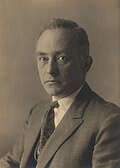 |
Max Born | December 11, 1882 Breslau, now Poland |
January 5, 1970 Göttingen, Germany |
1930, 1934, 1939, 1946, 1947, 1948, 1949, 1950, 1951, 1952, 1953, 1954 | Shared the 1954 Nobel Prize in Physics[ac] with W.W.G.Bothe.[175] |
 |
Henry Norris Russell | October 25, 1877 Oyster Bay, United States |
February 18, 1957 Princeton, New Jersey, United States |
1930, 1950, 1953 | [176] |
 |
Meghnad Saha | October 6, 1893 Shaoratoli near Dhaka, now Bangladesh |
February 16, 1956 New Delhi, India |
1930, 1937, 1939, 1940, 1951, 1955 | [177] |
 |
Ira Sprague Bowen | December 21, 1898 Seneca Falls, New York, United States |
February 6, 1973 Hollywood, United States |
1930, 1934, 1939, 1950, 1968 | [178] |
Close
1931–1939
More information Picture, Name ...
| Picture | Name | Born | Died | Years Nominated | Notes |
|---|---|---|---|---|---|
| 1931 – this year Prize was not awarded | |||||
 |
Victor Francis Hess | June 24, 1883 Schloss Waldstein, Peggau, Austria-Hungary |
December 17, 1964 Mount Vernon, New York, United States |
1931, 1933, 1935[d], 1936 | Shared the 1936 Nobel Prize in Physics[ad] with C.D.Anderson.[179] |
 |
George Paget Thomson Wave properties of electrons experimenters |
May 3, 1892 Cambridge, United Kingdom |
September 10, 1975 Cambridge, England |
1931, 1932, 1933, 1934, 1937 | Won the 1937 Nobel Prize in Physics with Cl.Davisson[aa][180] |
| 1931[d] | They nominated by Ern.G.Merritt the only time Ch.Alg.Parsons nominated by J.Ern.Petavel the only time but died before the only chance to be rewarded. [181] | ||||
 |
Charles Algernon Parsons | June 13, 1854 London, United Kingdom |
February 11, 1931 Kingston Harbour, Colony of Jamaica, British Empire | ||
 |
Georges Claude | September 24, 1870 Paris, France |
May 23, 1960 Saint-Cloud, France |
1931 | |
| 1932 – Prize has been awarded a year later | |||||
 |
Kotaro Honda | February 23, 1870 Okazaki, Aichi, Japan |
February 12, 1954 Tokyo, Japan |
1932 | [182] |
 |
Auguste Piccard | January 28, 1884 Basel, Switzerland |
March 24, 1962 Lausanne, Switzerland |
1932, 1933 | [183] |
 |
Arthur Eddington | December 28, 1882 Kendal, United Kingdom |
November 22, 1944 Cambridge, England |
1932, 1933, 1934, 1935, 1936, 1944 | [184] |
| 1933 | |||||
 |
Wolfgang Pauli | April 25, 1900 Vienna, Austria-Hungary |
December 15, 1958 Zürich, Switzerland |
1933, 1934, 1935, 1937, 1938, 1940, 1941, 1942, 1943, 1944, 1945, 1946 | Won the 1945 Nobel Prize in Physics[ae][185] |
| René-Paul-Eugène Thiry[186] | June 26, 1886 Langres, France |
October 5, 1968 Mar Vivo, La Seyne-sur-Mer, France |
1933 | Nominated the only time by O.Colard from Belgium.[187] | |
| 1934 – this year Prize was not awarded | |||||
 |
Carl David Anderson | September 3, 1905 New York City, United States |
January 11, 1991 San Marino, California, United States |
1934, 1935, 1936, 1941, 1942, 1944, 1945, 1946, 1947, 1948, 1949, 1950, 1951, 1952, 1953 |
Shared the 1936 Nobel Prize in Physics[af] with the V.Fr.Hess.[188] |
 |
Walther Bothe | January 8, 1891 Oranienburg, German Empire |
February 8, 1957 Heidelberg, Germany |
1934, 1935[d], 1936[d], 1946, 1949, 1951, 1952, 1953, 1954 | Shared the 1954 Nobel Prize in Physics[ag] with M.Born[189] |
 |
James Chadwick | October 20, 1891 Bollington, United Kingdom |
July 24, 1974 Cambridge, England |
1934, 1935, 1936[d], 1939 |
Won the 1935 Nobel Prize in Physics[ah][190] |
 |
Frédéric Joliot-Curie | March 19, 1900 Paris, France |
August 14, 1958 Paris, France |
1934, 1935, 1936[d] | [191] Shared the 1935 Nobel Prize in Chemistry [192] |
 |
Irène Joliot-Curie | September 12, 1897 Paris, France |
March 17, 1956 Paris, France | ||
 |
Harold Urey | April 29, 1893 Walkerton, Indiana, United States |
January 5, 1981 La Jolla, California, United States |
1934 | Won the 1934 Nobel Prize in Chemistry.[193] |
 |
Ferdinand Graft Brickwedde | March 26, 1903 Baltimore, United States |
March 29, 1989 Linwood, New Jersey, United States |
[194] Nominated jointly with H.Urey the only time by Fr.Horton [195] | |
| George Moseley Murphy[196] | June 1, 1903 Wilmington, North Carolina, United States |
December 7, 1968 New York City, United States | |||
| Gustav Waldemar Elmen | December 22, 1876 Stockholm, Sweden |
December 10, 1957 Englewood, New Jersey, United States |
1934 | Nominated the only time by H.F.Osborn.[197] | |
 |
Lars Vegard | February 3, 1880 Vegårshei, Norway |
December 21, 1963 Oslo, Norway |
1934 | Nominated jointly with C.Størmer the only time by Alfred Kalähne [de].[198] |
| Giancarlo Vallauri | October 19, 1882 Rome, Kingdom of Italy |
May 7, 1957 Turin, Italy |
1934, 1935, 1941 | [199] | |
| 1935 | |||||
 |
Enrico Fermi | September 29, 1901 Rome, Kingdom of Italy |
November 28, 1954 Chicago, United States |
1935, 1936, 1937, 1938, 1939, 1947, 1948 |
Won the 1938 Nobel Prize in Physics[ai] and nominated for the Nobel Prize in Chemistry too.[200] |
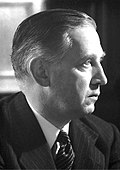 |
Edward Victor Appleton | September 6, 1892 Bradford, United Kingdom |
April 21, 1965 Edinburgh, United Kingdom |
1935, 1939, 1941, 1942, 1943, 1944, 1946, 1947 | Won the 1947 Nobel Prize in Physics[aj][201] |
 |
Arthur E. Kennelly | December 17, 1861 Colaba, now India |
June 18, 1939 Boston, Massachusetts, United States |
1935 | Nominated jointly with Edw.V.Appleton only.[202] |
| Alexander Gurwitsch | September 26, 1874 Poltava, now Ukraine |
July 27, 1954 Moscow, Russia |
1935 | Nominated jointly with H.Dingler and F.Ehrenhaft the only time by L.Zehnder and for the Nobel Prize in Physiology or Medicine too[ak][203][204] | |
| Hugo Dingler | July 7, 1881 Munich, German Empire |
June 29, 1954 Munich, Germany |
[205] Nominated jointly with Al.Gurwitsch the only time by L.Zehnder [206] | ||
 |
Felix Ehrenhaft | April 24, 1879 Vienna, Austria-Hungary |
March 4, 1952 Vienna, Austria | ||
 |
Abraham Esau | June 7, 1884 Tiegenhagen, now Poland |
May 12, 1955 Düsseldorf, Germany |
1935 | Nominated the only time by August Gärtner [de].[207] |
| John Cunningham McLennan | October 14, 1867 Ingersoll, Ontario, Canada |
October 9, 1935 Paris, France |
1935 | Nominated the only time by David Arnold Keys (1890–1977).[208][209] Died before the only chance to be rewarded. | |
| Fritz Zwicky | February 14, 1898 Varna, Bulgaria |
February 8, 1974 Pasadena, California, United States |
1935 | Nominated the only time by H.Bateman.[210] | |
| Max Cosyns[d] | May 29, 1906 Schaerbeek, Belgium |
March 30, 1998 Brussels, Belgium |
1935 | Nominated by Fr.-V.-M.Cumont the only time | |
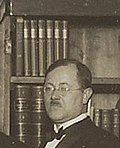 |
Wander Johannes de Haas | March 2, 1878 Lisse, Netherlands |
April 26, 1960 Bilthoven, Netherlands |
1935, 1936, 1937, 1938, 1939, 1940, 1941, 1942, 1943, 1945 | [211] |
 |
Hans Geiger | September 30, 1882 Neustadt an der Haardt, German Empire |
September 24, 1945 Potsdam, Germany |
1935, 1937, 1955 | [212] |
 |
Samuel Goudsmit | July 11, 1902 The Hague, Netherlands |
December 4, 1978 Reno, Nevada, United States |
1935, 1947, 1951, 1952, 1953, 1954, 1955, 1956, 1957, 1958, 1964, 1965, 1966, 1967, 1968, 1969, 1970, 1971, 1973, 1974 | [213] |
| 1936 | |||||
 |
Patrick Blackett | November 18, 1897 London, United Kingdom |
July 13, 1974 London, England |
1936, 1939, 1940, 1942, 1944, 1945, 1947, 1948, 1949 | Won the 1948 Nobel Prize in Physics[al][214] |
 |
Giuseppe Occhialini | December 5, 1907 Fossombrone, Kingdom of Italy |
December 30, 1993 Paris, France |
1936, 1949, 1950, 1952, 1953, 1954, 1955, 1956, 1957, 1958, 1959, 1961, 1963, 1964, 1965[am], 1968[am], 1969 | [215] |
 |
Jacob Clay | January 18, 1882 Berkhout, Netherlands |
December 31, 1955 De Bilt, Netherlands |
1936, 1952 | [216] |
| Hans (Richard (?)) Becker[d] |
December 3, 1887 Hamburg, German Empire (?) |
March 16, 1955 Bad Schwalbach, Germany (?) |
1936 | Nominated by S.J.Barnett the only time | |
| 1937 | |||||
 |
John Cockcroft | May 27, 1897 Todmorden, United Kingdom |
September 18, 1967 Cambridge, England |
1935[d], 1937, 1938, 1939, 1943, 1945, 1946, 1947, 1949, 1951, 1952 | [217] Shared the 1951 Nobel Prize in Physics[an] [218] |
 |
Ernest Walton | October 6, 1903 Abbeyside, United Kingdom of Great Britain and Ireland |
June 25, 1995 Belfast, United Kingdom |
1935[d], 1937, 1938, 1939, 1945, 1947, 1951 | |
 |
Otto Hahn | March 8, 1879 Frankfurt, German Empire |
July 28, 1968 Göttingen, Germany |
1937, 1940, 1941, 1943, 1945, 1946, 1947 | Won the 1944 Nobel Prize in Chemistry in 1945.[219] |
 |
Lise Meitner | November 7, 1878 Vienna, Austria-Hungary |
October 27, 1968 Cambridge, United Kingdom |
1937, 1940, 1941, 1943, 1945, 1946, 1947, 1948, 1949, 1954, 1955, 1956, 1959, 1961, 1964, 1965, 1967 | Nominated for the Nobel Prize in Chemistry too.[220] |
 |
Alfred Lee Loomis | November 4, 1887 Manhattan, New York, United States |
August 11, 1975 East Hampton (town), New York, United States |
1937 | Nominated jointly with R.W.Wood only.[221] |
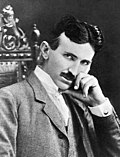 |
Nikola Tesla | July 7, 1856 Smiljan, now Croatia |
January 7, 1943 New York City, United States |
1937 | Nominated the only time by F.Ehrenhaft.[222] |
 |
Gilles Holst | March 20, 1886 Haarlem, Netherlands |
October 11, 1968 Waalre, Netherlands |
1937, 1944 | [223] |
| Geoffrey Ingram Taylor | March 7, 1886 St. John's Wood, United Kingdom |
June 27, 1975 Cambridge, England |
1937, 1945, 1953, 1954, 1955, 1956, 1957, 1958, 1959, 1961, 1963, 1968, 1969, 1970, 1973, 1974 | Nominated for the Nobel Prize in Chemistry too.[224][225] | |
| 1938 | |||||
 |
Ernest Lawrence | August 8, 1901 Canton, South Dakota, United States |
August 27, 1958 Palo Alto, California, United States |
1938, 1939, 1940 | Won the 1939 Nobel Prize in Physics[ao][226] |
 |
Erich Regener | November 12, 1881 Schleusenau [pl], now Poland |
February 27, 1955 Stuttgart, Germany |
1938 | Nominated the only time by Erw.Schrödinger.[227] |
| 1939 | |||||
 |
Isidor Isaac Rabi | July 29, 1898 Rymanów, now Poland |
January 11, 1988 New York City, United States |
1939, 1940, 1941, 1942, 1943, 1944, 1945 | Won the 1944 Nobel Prize in Physics[ap][228] |
 |
Albert W. Hull | April 19, 1880 Southington, Connecticut, United States |
January 22, 1966 Schenectady, New York, United States |
1939 | Nominated jointly with P.Debye and P.Scherrer the only time by Harald Perlitz [et].[229] |
 |
Paul Scherrer | February 3, 1890 St. Gallen, Switzerland |
September 25, 1969 Zürich, Switzerland |
1939, 1951 | [230] |
Close
1940–1949
More information Picture, Name ...
| Picture | Name | Born | Died | Years Nominated | Notes |
|---|---|---|---|---|---|
| 1940 – this year Prize was not awarded | |||||
 |
Hideki Yukawa | January 23, 1907 Tokyo, Japan |
September 8, 1981 Kyoto, Japan |
1940, 1941, 1943, 1944, 1945, 1946, 1948, 1949, 1950 | Won the 1949 Nobel Prize in Physics[aq] and nominated for Nobel Peace Prize too[231] |
 |
William Giauque | May 12, 1895 Niagara Falls, Ontario, Canada |
March 28, 1982 Berkeley, California, United States |
1940 | Won the 1949 Nobel Prize in Chemistry.[232] |
 |
Jaroslav Heyrovský | December 20, 1890 Prague, Czechia |
March 27, 1967 Prague, Czechia |
1940 | Won the 1959 Nobel Prize in Chemistry and nominated for the Nobel Prize in Physiology or Medicine too[ar][233] |
| Henri Bouasse [fr] | November 16, 1866 Paris, France |
November 15, 1953 Toulouse, France |
1940 | [234] Nominated jointly the only time by R. de Mallemann [fr]. [as] Chamberlain: Prime Minister of the United Kingdom (1937–1940) Chamberlain nominated for the Nobel Peace Prize too[235] | |
 |
Neville Chamberlain | March 8, 1869 Edgbaston, United Kingdom |
November 9, 1940 Heckfield, England | ||
 |
Willem Hendrik Keesom | June 21, 1876, Texel, Netherlands |
March 24, 1956 Leiden, Netherlands |
1940, 1943, 1944, 1945, 1947, 1948, 1955 | [236] |
| 1941 – this year Prize was not awarded | |||||
| Fritz Strassmann | February 22, 1902 Boppard, German Empire |
April 22, 1980 Mainz, Germany |
1941, 1945, 1946 | Nominated jointly with Otto Hahn only.[237] | |
 |
Seth Neddermeyer | September 16, 1907 Richmond, Michigan, United States |
January 29, 1988 Seattle, Washington, United States |
1941, 1942, 1944, 1945, 1946, 1947, 1948, 1949, 1950, 1951, 1952 | Nominated jointly with or by C.D.Anderson only.[238] |
| Pierre Victor Auger | May 14, 1899 Paris, France |
December 25, 1993 Paris, France |
1941, 1947, 1948, 1949, 1951, 1953 | [239] | |
| 1942 – this year Prize was not awarded | |||||
 |
George de Hevesy | August 1, 1885 Budapest, Austria-Hungary |
July 5, 1966 Freiburg im Breisgau, Germany |
1942 | Won the 1943 Nobel Prize in Chemistry in 1944 and nominated for the Nobel Prize in Physiology or Medicine too.[240] |
| 1943 – Prize has been awarded a year later | |||||
 |
Hans Bethe | July 2, 1906 Strasbourg, now France |
March 6, 2005 Ithaca, New York, United States |
1943, 1946, 1948, 1949, 1950, 1951, 1953, 1954, 1955, 1956, 1957, 1958, 1959, 1960, 1962, 1964, 1965, 1966, 1967 | Won the 1967 Nobel Prize in Physics[at][241] |
 |
Santiago Antúnez de Mayolo | January 10, 1887 Huacllan District, Aija Province, Department of Ancash, Peru |
April 20, 1967 Lima, Peru |
1943 | Nominated the only time by C.Granda from Lima.[242] |
 |
Donald William Kerst | November 1, 1911 Galena, Illinois, United States |
August 19, 1993 Madison, Wisconsin, United States |
1943, 1945, 1946, 1947, 1948, 1949, 1951, 1952, 1953, 1956, 1969 | [243] |
 |
George Gamow | March 4, 1904 Odesa, now Ukraine |
August 19, 1968 Boulder, Colorado, United States |
1943, 1946, 1967, 1974 | [244] |
| 1944 | |||||
 |
Frits Zernike | July 16, 1888 Amsterdam, Netherlands | March 10, 1966 Amersfoort, Netherlands | 1944, 1948, 1950, 1951, 1952, 1953 | Won the 1953 Nobel Prize in Physics[au] and nominated for the Nobel Prize in Chemistry too.[245] |
 |
Henk Dorgelo | February 9, 1894 Dedemsvaart, Netherlands |
March 6, 1961 Eindhoven, Netherlands |
1944 | [246] Nominated jointly with G.Holst the only time by G.J.Elias [nl] [247] [248] |
| Willem Christiaan van Geel[249] | October 27, 1895 Haarlemmermeer, Netherlands |
August 23, 1967 Eindhoven, Netherlands | |||
| Frans Michel Penning | September 12, 1894 Gorinchem, Netherlands |
December 6, 1953 Utrecht, Netherlands | |||
| 1945 | |||||
| Bernard Lyot | February 27, 1897 Paris, France |
April 2, 1952 Cairo, Egypt |
1945, 1947, 1948, 1949, 1950, 1951, 1952 | [250] | |
 |
Otto Robert Frisch | October 1, 1904 Vienna, Austria-Hungary |
September 22, 1979 Cambridge, United Kingdom |
1945, 1946, 1947, 1948, 1959, 1961, 1963, 1967 | Nominated for the Nobel Prize in Chemistry too.[251] |
| 1946 | |||||
 |
Pyotr Kapitsa | July 8, 1894 Kronstadt, Russian Empire |
April 8, 1984 Moscow, Russia |
1946, 1947, 1948, 1950, 1953, 1955, 1956, 1957, 1958, 1959, 1960, 1965, 1966, 1968, 1969, 1970, 1971, 1972, 1973, 1974 | Shared the 1978 Nobel Prize in Physics[av] with A.A.Penzias and R.W.Wilson[252] |
| Nuclear Scientists | 1946, 1947 | [253] | |||
 |
Arthur Jeffrey Dempster | August 14, 1886 Toronto, Canada |
March 11, 1950 Stuart, Florida, United States |
1946, 1948 | [254] |
 |
Francis Simon | July 2, 1893 Berlin, German Empire |
October 31, 1956 Oxford, United Kingdom |
1946, 1953, 1956 | Nominated for the Nobel Prize in Chemistry too.[255] |
 |
J. Robert Oppenheimer | April 22, 1904 New York City, United States |
February 18, 1967 Princeton, New Jersey, United States |
1946, 1951, 1955, 1967 | [256] |
| 1947 | |||||
 |
Edwin McMillan | September 18, 1907 Redondo Beach, California, United States |
September 7, 1991 El Cerrito, California, United States |
1947, 1948, 1951, 1956, 1965 |
Shared the 1951 Nobel Prize in Chemistry with Gl.T.Seaborg.[257] |
| Vladimir Veksler | March 4, 1907 Zhytomyr, now Ukraine |
September 22, 1966 Moscow, Russia |
1947, 1948, 1951, 1956, 1957, 1959, 1964, 1965 | [258] | |
| Camille Gutton | August 30, 1872 Nancy, France |
August 19, 1963 Saint-Nom-la-Bretèche, France |
1947 | Nominated the only time by L. de Broglie.[259] | |
 |
Robert Serber | March 14, 1909 Philadelphia, United States |
June 1, 1997 New York City, United States |
1947 | Nominated jointly with D.W.Kerst by Cz.Białobrzeski the only time.[260] |
 |
Karl-Friedrich Bonhoeffer | January 13, 1899 Breslau, now Poland |
May 15, 1957 Göttingen, Germany |
1947, 1949 | Nominated by W.Heisenberg only and for the Nobel Prize in Chemistry too.[261] |
| Klaus Clusius | March 19, 1903 Breslau, now Poland |
May 28, 1963 Zürich, Switzerland |
1947, 1949, 1953, 1955, 1956, 1957, 1958, 1959, 1960, 1962, 1963 | Nominated for the Nobel Prize in Chemistry too.[262] | |
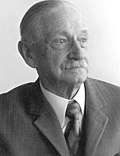 |
Walther Meissner | December 16, 1882 Berlin, German Empire |
November 16, 1974 Munich, Germany |
1947, 1950, 1955, 1966, 1967 | [263] |
| Dmitri Skobeltsyn | November 24, 1892 Saint Petersburg, Russian Empire |
November 16, 1990 Moscow, Russia |
1947 | Nominated jointly with Br.Rossi, P.Blackett and P.V.Auger the only time by Cz.Białobrzeski.[264] | |
 |
Bruno Rossi | April 13, 1905 Venice, Kingdom of Italy |
November 21, 1993 Cambridge, Massachusetts, United States |
1947, 1948, 1949, 1952, 1954, 1955, 1956, 1957, 1958, 1959, 1960, 1961, 1962, 1963, 1965, 1966, 1967, 1968, 1971, 1973 | [265][266] |
 |
Llewellyn Thomas | October 21, 1903 London, United Kingdom |
April 20, 1992 Raleigh, North Carolina, United States |
1947, 1968 | Nominated jointly with S.Goudsmit and G.Uhlenbeck only.[267] |
 |
George Uhlenbeck | December 6, 1900 Batavia, now Indonesia |
October 31, 1988 Boulder, Colorado, United States |
1947, 1951, 1952, 1953, 1954, 1955, 1956, 1957, 1958, 1964, 1965, 1966, 1967, 1968, 1969, 1970, 1971, 1973, 1974 | Nominated jointly with S.Goudsmit only.[268] |
| 1948 | |||||
| Helmut Scheffers[269] | September 13, 1898 Darmstadt, German Empire |
February 25, 1963 West Berlin, Germany |
1948 | Nominated the only time by J.Stark.[270] | |
 |
Balthasar van der Pol | January 27, 1889 Utrecht, Netherlands |
October 6, 1959 Wassenaar, Netherlands |
1948, 1949, 1950 | Nominated by brothers Louis and M. de Broglie only.[271] |
| Marcel Schein | June 9, 1902 Trstená, now Slovakia |
February 20, 1960 Chicago, United States |
1948, 1949, 1951, 1952 | [272] | |
| Walter Grotrian | April 21, 1890 Aachen, German Empire |
March 3, 1954 Potsdam, Germany |
1948 | Nominated jointly with B.Edlén and B.Lyot the only time by Alfred Kastler.[273] | |
| Henry Lincoln Yeagley, Sr.[274] | July 17, 1899 York, Pennsylvania, United States |
December 26, 1996 State College, Pennsylvania, United States |
1948 | [275] Nominated jointly with R.W.Pohl the only time by W.O.Schumann [276] | |
 |
Karl Guthe Jansky | October 22, 1905 Norman, Oklahoma, United States |
February 14, 1950 Red Bank, New Jersey, United States | ||
 |
Robert Wichard Pohl | August 10, 1884 Hamburg, German Empire |
June 5, 1976 Göttingen, Germany |
1948, 1953, 1957, 1959, 1967[am] | [277] |
 |
Bengt Edlén | November 2, 1906, Gusum, Sweden |
February 10, 1993 Lund, Sweden |
1948, 1950, 1954, 1956, 1957, 1960, 1963, 1964, 1974 | [278] |
 |
Felix Bloch | October 23, 1905 Zürich, Switzerland |
September 10, 1983 Zürich, Switzerland |
1948, 1949, 1950, 1951, 1952, 1953, 1974 |
[279] Shared the 1952 Nobel Prize in Physics[aw] [280] |
| 1949 | |||||
 |
Edward Mills Purcell | August 30, 1912 Taylorville, Illinois, United States |
March 7, 1997 Cambridge, Massachusetts, United States |
1949, 1950, 1951, 1952 | |
 |
C. F. Powell | December 5, 1903 Tonbridge, United Kingdom |
August 9, 1969 Valsassina, Italy |
1949, 1950, 1951 | Won the 1950 Nobel Prize in Physics[ax][281] |
 |
César Lattes | July 11, 1924 Curitiba, Brazil |
March 8, 2005 Campinas, Brazil |
1949, 1951, 1952, 1953, 1954 | [282] |
| Eugene Hill Gardner[283] | March 22, 1913 Logan, Utah, United States[284] |
November 27, 1950 Vallejo, California, United States |
1949 | Nominated jointly with C.Lattes the only time by W.Sc.Hill Rodriguez (1903–1987)[285] from Montevideo.[286] | |
 |
Vannevar Bush | March 11, 1890 Everett, Massachusetts, United States |
June 28, 1974 Belmont, Massachusetts, United States |
1949 | Nominated the only time by Arthur C. Hardy.[287] |
| Alfred O. C. Nier | May 28, 1911 St. Paul, Minnesota, United States |
May 16, 1994 Hennepin County Medical Center, United States |
1949 | Nominated the only time by J.L.Kerwin and for the Nobel Prize in Chemistry too.[288][289] | |
| Albert Portevin | November 1, 1880 Paris, France |
April 12, 1962 Abano Terme, Italy |
1949 | Nominated the only time by C.Benedicks and for the Nobel Prize in Chemistry too.[290] | |
 |
Leo Szilard | February 11, 1898 Budapest, Austria-Hungary |
May 30, 1964 San Diego, United States |
1949 | Nominated the only time by M.Goldhaber and for the Nobel Prize in Chemistry too.[291] |
 |
Hans Kramers | February 2, 1894 Rotterdam, Netherlands |
April 24, 1952 Oegstgeest, Netherlands |
1949, 1950, 1952 | [292] |
| Harold Jeffreys | 22 April 1891 Fatfield, United Kingdom |
18 March 1989 Cambridge, England |
1949, 1964, 1966 | [293] | |
| Edward Carl Stevenson[294] | March 9, 1907 Sumpter, Oregon, United States |
July 23, 2002 Charlottesville, Virginia, United States |
1949 | Nominated jointly with C.D.Anderson, S.Neddermeyer, H.Yukawa and J.C.Street the only time by Peter Gerald Kruger (1902–1978) from Urbana, Illinois, United States[295] | |
| J. Curry Street | May 5, 1906 Opelika, Alabama, United States |
November 7, 1989 Charleston, South Carolina, United States |
1949, 1953, 1954, 1955, 1956, 1959, 1962, 1967 | [296] | |
| Lawrence R. Hafstad | June 18, 1904 Minneapolis, United States |
October 12, 1993 Oldwick, New Jersey, United States |
1949 | [297] Nominated jointly with Gr.Breit the only time by W.S.Adams [298] | |
| Merle Tuve | June 27, 1901 Canton, South Dakota, United States |
May 20, 1982 Bethesda, Maryland, United States | |||
 |
Gregory Breit | July 14, 1899 Mykolaiv, now Ukraine |
September 13, 1981 Salem, Oregon, United States |
1949, 1970, 1971, 1972, 1973 | [299] |
Close
1950–1959
More information Picture, Name ...
| Picture | Name | Born | Died | Years Nominated | Notes |
|---|---|---|---|---|---|
| 1950 | |||||
 |
Georg von Békésy | June 3, 1899 Budapest, Austria-Hungary |
June 13, 1972 Honolulu, United States |
1950, 1953, 1954, 1958 | Won the 1961 Nobel Prize in Physiology or Medicine.[300] |
| Josef Mattauch | November 21, 1895 Ostrava, Czechia |
August 10, 1976 Klosterneuburg, Austria |
1950 | Nominated jointly with W.Kossel the only time by F.K.L.Machatschki and for the Nobel Prize in Chemistry too.[301] | |
 |
Walther Kossel | January 4, 1888 Berlin, German Empire |
May 22, 1956 Tübingen, Germany |
1950, 1954, 1955 | Nominated for the Nobel Prize in Chemistry too.[302] |
| Hertha Wambacher | March 9, 1903 Vienna, Austria-Hungary |
April 25, 1950 Vienna, Austria |
1950 | Nominated jointly with M.Blau the only time by Erwin Schrödinger.[303] Died before the only chance to be rewarded. | |
 |
Marietta Blau | April 29, 1894 Vienna, Austria-Hungary |
January 27, 1970 Vienna, Austria |
1950, 1955, 1956, 1957 | Nominated for the Nobel Prize in Chemistry too.[304] |
| Horace W. Babcock | September 13, 1912 Pasadena, California, United States |
August 29, 2003 Santa Barbara, California, United States |
1950, 1956, 1958 | Nominated by Al.H.G.Dauvillier[ay] only[305] | |
 |
Grote Reber | December 22, 1911 Wheaton, Illinois, United States |
December 20, 2002 Ouse, Tasmania, Australia |
1950, 1967, 1969 | [306] |
| 1951 | |||||
 |
Julian Schwinger | February 12, 1918 New York City, United States |
July 16, 1994 Los Angeles, United States |
1951, 1952, 1956, 1957, 1960, 1962, 1963, 1964, 1965, 1966 | [307] Shared the 1965 Nobel Prize in Physics with R.Ph.Feynman[az] [308] |
 |
Shin'ichirō Tomonaga | March 31, 1906 Tokyo, Japan |
July 8, 1979 Tokyo, Japan |
1951, 1952, 1955, 1956, 1957, 1960, 1962, 1963, 1964, 1965 | |
 |
Luis Walter Alvarez | June 13, 1911 San Francisco, California, United States |
September 1, 1988 Berkeley, California, United States |
1951, 1953, 1960, 1962, 1963, 1964, 1965, 1966, 1967, 1968 | Won the 1968 Nobel Prize in Physics[ba][309] |
 |
Willis Lamb | July 12, 1913 Los Angeles, United States |
May 15, 2008 Tucson, United States |
1951, 1952, 1953, 1954, 1955 | Shared the 1955 Nobel Prize in Physics[bb] with P.Kusch[310] |
| Robert Curtis Retherford | 1912 Carthage, Indiana, United States |
1981 |
1951, 1952, 1953, 1955 | Nominated jointly with W.Lamb only.[311] | |
| William Francis Gray Swann | August 29, 1884 Ironbridge Gorge, United Kingdom |
January 29, 1962 Swarthmore, Pennsylvania, United States |
1951, 1952, 1953 | Nominated jointly with C.D.Anderson by V.Fr.Hess only.[312] | |
 |
Homi J. Bhabha | October 30, 1909 Bombay, India |
January 24, 1966 Mont Blanc, Alps |
1951, 1953, 1954, 1955, 1956 | Nominated by J.Hadamard only.[313] |
| Erwin Wilhelm Müller | June 13, 1911 Berlin, German Empire |
May 17, 1977 Washington, D.C., United States |
1951, 1952, 1953, 1957, 1959, 1960, 1962, 1963, 1966, 1968, 1969, 1970, 1971, 1972, 1973, 1974 | Nominated for the Nobel Prize in Chemistry too.[314][315] | |
 |
Pascual Jordan | 18 October 1902 Hannover, German Empire |
31 July 1980 Hamburg, Germany |
1951, 1963, 1967, 1970, 1971, 1972, 1973, 1974 | [316][317] |
| Wolfgang K. H. Panofsky | April 24, 1919 Berlin, Germany |
September 24, 2007 Los Altos, California, United States |
1951, 1952, 1953, 1956, 1957, 1959, 1962, 1967, 1971, 1972, 1973, 1974 | [318] | |
 |
John Hasbrouck Van Vleck | March 13, 1899 Middletown, Connecticut, United States |
October 27, 1980 Cambridge, Massachusetts, United States |
1951, 1961, 1965, 1966, 1967, 1968, 1969, 1970, 1971, 1972, 1973, 1974 | [319] Shared the 1977 Nobel Prize in Physics with Ph.W.Anderson[bc] [320] |
| 1952 | |||||
 |
Nevill Francis Mott | September 30, 1905 Leeds, United Kingdom |
August 8, 1996 Milton Keynes, England |
1952, 1958, 1960, 1961, 1968, 1969, 1970, 1971, 1972, 1973, 1974 | |
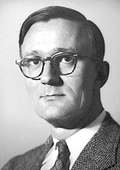 |
Polykarp Kusch | January 26, 1911 Blankenburg (Harz), German Empire |
March 20, 1993 Dallas, United States |
1952, 1955 | Shared the 1955 Nobel Prize in Physics[bd] with W.Lamb[321] |
 |
Pavel Cherenkov | July 28, 1904 Novaya Chigla, Russian Empire |
January 6, 1990 Moscow, Russia |
1952, 1955, 1956, 1957, 1958 | Shared the 1958 Nobel Prize in Physics with Ig.Tamm and Il.Frank[be][322] |
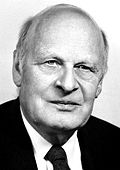 |
Lars Onsager | November 27, 1903 Kristiania, Norway |
October 5, 1976 Coral Gables, Florida, United States |
1952, 1953, 1954, 1956, 1957, 1958, 1961, 1963, 1964, 1965, 1966, 1967, 1968 | Won the 1968 Nobel Prize in Chemistry.[323] |
| Helmut L. Bradt[324] | December 11, 1917 Berlin, German Empire |
May 24, 1950 Brooklyn, United States |
1952 | [325] Nominated jointly (Bradt – posthumously) with J.Clay the only time by Al.H.G.Dauvillier[ay] [326] | |
| Bernard Peters | December 22, 1910 Posen, now Poland |
February 2, 1993 Copenhagen, Denmark | |||
| Samuel Jackson Barnett | December 14, 1873 Woodson County, Kansas, United States |
May 22, 1956 Pasadena, California, United States |
1952, 1953, 1954, 1955, 1956 | [327] | |
| Georges Destriau | 1 August 1903 Bordeaux, France |
20 January 1960 Paris, France |
1952, 1962 | [328] | |
 |
Louis Néel | November 22, 1904 Lyon, France |
November 17, 2000 Brive-la-Gaillarde, France |
1952, 1953, 1954, 1955, 1956, 1957, 1958, 1959, 1960, 1961, 1962, 1963, 1964, 1965, 1966, 1967, 1968, 1969, 1970 | [bf][329] Shared the 1970 Nobel Prize in Physics L.Néel nominated for the Nobel Prize in Chemistry too [bg][330] |
| 1953 | |||||
 |
Hannes Alfvén | May 30, 1908 Norrköping, Sweden |
April 2, 1995 Djursholm, Sweden |
1953, 1960, 1961, 1962, 1963, 1964, 1965, 1966, 1967, 1968, 1969, 1970 | |
 |
Emilio Segrè | February 1, 1905 Tivoli, Italy, |
April 22, 1989 Lafayette, California, United States |
1953, 1956, 1957, 1958, 1959 | Shared the 1959 Nobel Prize in Physics with O.Chamberlain[bh] and nominated for the Nobel Prize in Chemistry too[331] |
 |
Eugene Wigner | November 17, 1902 Budapest, Austria-Hungary |
January 1, 1995 Princeton, New Jersey, United States |
1953, 1955, 1957, 1958, 1959, 1960, 1961, 1962, 1963, 1974 |
Shared the 1963 Nobel Prize in Physics[bi] with J.H.D.Jensen and M.Goeppert-Mayer[332] |
| Willard Libby | December 17, 1908 Grand Valley, United States |
September 8, 1980 Los Angeles, United States |
1953, 1956, 1957, 1960 | Won the 1960 Nobel Prize in Chemistry.[333] | |
 |
Edwin Hubble | November 20, 1889 Marshfield, Missouri, United States |
September 28, 1953 San Marino, California, United States |
1953 | Died before the only chance to be rewarded.[334] |
 |
Carl Friedrich von Weizsäcker | June 28, 1912 Kiel, German Empire |
April 28, 2007 Starnberg, Germany |
1953, 1958, 1964, 1965 | [335] |
 |
Robert J. Van de Graaff | December 20, 1901 Tuscaloosa, Alabama, United States |
January 16, 1967 Boston, Massachusetts, United States |
1953, 1964, 1966 | [336] |
 |
Louis Leprince-Ringuet | March 27, 1901 Alès, France |
December 23, 2000 Paris, France |
1953, 1954, 1955, 1956, 1957, 1960, 1966[am], 1967[am] | [337] |
 |
John Bardeen | May 23, 1908 Madison, Wisconsin, United States |
January 30, 1991 Boston, Massachusetts, United States |
1953, 1954, 1955, 1956, 1961, 1963, 1965, 1966, 1967, 1968, 1969, 1970, 1971, 1972 |
J.Bardeen shared 1972 Nobel Prize in Physics with L.Cooper and J.R.Schrieffer[bj] too[338] W.H.Brattain nominated for the Nobel Prize in Chemistry too[339] Shared the 1956 Nobel Prize in Physics[bk] [340] |
 |
Walter Houser Brattain | February 10, 1902 Xiamen, China |
October 13, 1987 Seattle, Washington, United States |
1953, 1954, 1956 | |
| 1954 | |||||
 |
William Shockley | February 13, 1910 Greater London, United Kingdom |
August 12, 1989 Stanford, California, United States |
1954, 1955, 1956 | |
 |
Lev Landau | January 22, 1908 Baku, now Azerbaijan |
April 1, 1968 Moscow, Russia |
1954, 1956, 1957, 1958, 1959, 1960, 1962, 1963 | Won the 1962 Nobel Prize in Physics[bl][341] |
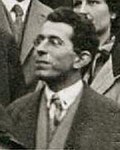 |
Fritz London | March 7, 1900 Breslau, now Poland |
March 30, 1954 Durham, North Carolina, United States |
1954 | Nominated jointly with L.Landau the only time by R.Marschak and for the Nobel Prize in Chemistry too.[342] Died before the chance to be rewarded. |
 |
Ilya Prigogine | January 25, 1917 Moscow, Russian Empire |
May 28, 2003 Brussels, Belgium |
1954, 1958, 1964, 1970, 1972, 1973, 1974 | Won the 1977 Nobel Prize in Chemistry.[343] |
| Jean Laval [fr] | January 31, 1900 Saint-Pardoux-le-Vieux, France |
March 4, 1980 Paris, France |
1954 | Nominated the only time by A.Lichnorowicz.[344] | |
| Georges Lemaître | July 17, 1894 Charleroi, Belgium |
June 20, 1966 Leuven, Belgium |
1954 | Nominated the only time by Al.H.G.Dauvillier[ay] and for the Nobel Prize in Chemistry too.[345] | |
 |
Vladimir K. Zworykin | July 29, 1888 Murom, Russian Empire |
July 29, 1982 Princeton, New Jersey, United States |
1954 | Nominated the only time by Vitomir H. Pavloviћ[346] (9.II 1897, Опланићи – 1959) from the University of Belgrade.[347] |
 |
James Gilbert Baker | November 11, 1914 Louisville, Kentucky, United States |
June 29, 2005 Bedford, New Hampshire, United States |
1954 | [348] [349] Nominated jointly with Edw.H.Land, B.Edlén and M.Deutsch the only time by H.Shapley [350] |
| Edward Linfoot | June 8, 1905 Sheffield, United Kingdom |
October 14, 1982 Cambridge, England | |||
 |
Karl Lark-Horovitz | July 20, 1892 Vienna, Austria-Hungary |
April 14, 1958 West Lafayette, Indiana, United States | ||
 |
Maurice Goldhaber | April 18, 1911 Lviv, now Ukraine |
May 11, 2011 East Setauket, New York, United States |
1954, 1959, 1960, 1962, 1970 | [351] |
| Edwin H. Land | May 7, 1909 Bridgeport, Connecticut, United States |
March 1, 1991 Cambridge, Massachusetts, United States |
1954, 1973, 1974 | Nominated for the Nobel Prize in Chemistry too[352] | |
 |
Martin Deutsch | January 29, 1917 Vienna, Austria-Hungary |
August 16, 2002 Cambridge, Massachusetts, United States |
1954, 1955, 1956, 1957, 1958, 1960, 1974 | Nominated for the Nobel Prize in Chemistry too.[353] |
| 1955 | |||||
| Ernst Ruska | December 25, 1906 Heidelberg, German Empire |
May 27, 1988 West Berlin, Germany |
1955, 1957, 1960, 1961, 1965, 1966, 1969, 1970, 1971, 1972, 1973, 1974 | Shared the 1986 Nobel Prize in Physics[bm] with G.Binnig and H.Rohrer and nominated for the Nobel Prizes both in Chemistry and Physiology or Medicine too.[bn][354] | |
| Bodo von Borries | May 22, 1905 Herford, German Empire |
July 17, 1956 Aachen, Germany |
1955 | Nominated jointly with Ernst Ruska only and for the Nobel Prize in Physiology or Medicine too. [bn][355][356] | |
| Max Knoll | July 17, 1897 Schlangenbad, German Empire |
November 6, 1969 Munich, Germany |
1955, 1957, 1961, 1967 | [357] | |
 |
Léon Brillouin | August 7, 1889 Sèvres, France |
October 4, 1969 New York City, United States |
1955, 1957, 1960, 1965, 1967, 1969 | [358] |
| Christiaan Alexander Muller | April 18, 1923 Alkmaar, Netherlands |
August 8, 2004 Delden, Netherlands |
1955, 1956, 1957, 1958, 1961 | Nominated jointly with J.Oort and H.C. van de Hulst only.[359] | |
 |
Jan Oort | April 28, 1900 Franeker, Netherlands |
November 5, 1992 Leiden, Netherlands |
1955, 1956, 1957, 1958, 1959, 1960, 1961, 1971, 1974 | [360] |
 |
Hendrik C. van de Hulst | November 19, 1918 Utrecht, Netherlands |
July 31, 2000 Leiden, Netherlands |
1955, 1956, 1957, 1958, 1960, 1961, 1964, 1966, 1967, 1968, 1972, 1973, 1974 | [361] |
| George Rochester | February 4, 1908 Wallsend, United Kingdom |
December 26, 2001 Durham, England |
1955, 1957, 1958, 1959, 1961, 1962, 1963, 1964, 1965, 1966[am], 1967[am], 1968[am], 1969[am], 1974 | [362] | |
 |
J. Hans D. Jensen | June 25, 1907 Hamburg, German Empire |
February 11, 1973 Heidelberg, Germany |
1955, 1956, 1957, 1958, 1959, 1960, 1961, 1962, 1963 | [363] Shared the 1963 Nobel Prize in Physics[bo] with E.Wigner and nominated for the Nobel Prize in Chemistry too [364] |
 |
Maria Goeppert Mayer | June 28, 1906 Kattowitz, now Poland |
February 20, 1972 San Diego, California, United States |
1955, 1956, 1957, 1958, 1959, 1960, 1962, 1963 | |
| 1956 | |||||
 |
Otto Haxel | April 2, 1909, Neu-Ulm, German Empire |
February 26, 1998 Heidelberg, Germany |
1956, 1957 | [365] Nominated jointly with J.H.D.Jensen and M.Goeppert Mayer by Karl Freudenberg only [366] |
| Hans Suess | December 16, 1909 Vienna, Austria-Hungary |
September 20, 1993 La Jolla, California, United States | |||
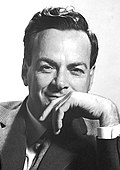 |
Richard Feynman | May 11, 1918 New York City, United States |
February 15, 1988 Los Angeles, United States |
1956, 1957, 1960, 1962, 1963, 1964, 1965, 1967 |
Shared the 1965 Nobel Prize in Physics with J.Schwinger and Sh.Tomonaga[az][367] |
 |
Alfred Kastler | 3 May 1902 Guebwiller, now France |
7 January 1984 Bandol, France |
1956, 1958, 1959, 1960, 1961, 1962, 1963, 1964, 1965, 1966 | Won the 1966 Nobel Prize in Physics[bp][368] |
 |
Dorothy Crowfoot Hodgkin | May 12, 1910 Cairo, Egypt |
July 29, 1994 Ilmington, United Kingdom |
1956, 1957, 1959, 1960, 1961 | Won the 1964 Nobel Prize in Chemistry.[369] |
| Jan Hendrik de Boer | March 19, 1899 Ruinen, Netherlands |
April 25, 1971 The Hague, Netherlands |
1956 | Nominated the only time by Antoine Hautot (1909–1998) from Liège.[370] | |
 |
Lee de Forest | August 26, 1873 Council Bluffs, Iowa, United States |
June 30, 1961 Hollywood, United States |
1956 | Nominated the only time by Cl.Davisson.[371] |
 |
Mark Oliphant | October 8, 1901 Adelaide, Australia |
July 14, 2000 Canberra, Australia |
1956 | Nominated the only time by L.Ružička.[372] |
| Gerald Pearson | March 31, 1905 Salem, Oregon, United States |
October 25, 1987 Portola Valley, California, United States |
1956 | Nominated jointly with J.Bardeen and W.H.Brattain the only time by Mariano Velasco Durántez (1897–1984) from University of Barcelona.[373] | |
| Gustav Ising | February 19, 1883 Finja, Sweden |
February 5, 1960 Danderyd Municipality, Sweden |
1956 | Nominated jointly with D.W.Kerst and R.Widerøe the only time by Ern.Walton.[374] | |
| Rolf Widerøe | July 11, 1902 Kristiania, Norway |
October 11, 1996 Obersiggenthal, Switzerland |
1956, 1969 | Nominated jointly with D.W.Kerst only.[375] | |
 |
Sydney Chapman | January 29, 1888 Eccles, Greater Manchester, United Kingdom |
June 16, 1970 Boulder, Colorado, United States |
1956, 1959, 1961, 1963, 1967, 1968, 1970 | [376] |
| Cornelis Jacobus Gorter | August 14, 1907, Utrecht, Netherlands |
30 March 1980 Leiden, Netherlands |
1956, 1957, 1959, 1964, 1965, 1966, 1968, 1969, 1970, 1971, 1972, 1973 | [377] | |
 |
Satyendra Nath Bose | January 1, 1894 Calcutta, India |
February 4, 1974 Calcutta, India |
1956, 1959, 1962, 1968, 1969, 1970, 1971, 1972, 1974 | [378][379] |
| 1957 | |||||
 |
Igor Tamm | July 8, 1895 Vladivostok, Russian Empire |
April 12, 1971 Moscow, Russia |
1957, 1958 | [380] Shared the 1958 Nobel Prize in Physics with P.A.Cherenkov[be] [381] |
 |
Ilya Frank | October 23, 1908 Saint Petersburg, Russian Empire |
June 22, 1990 Moscow, Russia | ||
 |
Sergey Ivanovich Vavilov | March 24, 1891 Moscow, Russian Empire |
January 25, 1951 Moscow, Russia |
1957, 1958 | Posthumously nominated jointly with P.A.Cherenkov only.[382] |
 |
Owen Chamberlain | July 10, 1920 San Francisco, California, United States |
February 28, 2006 Berkeley, California, United States |
1957, 1958, 1959 | Shared the 1959 Nobel Prize in Physics with Em.Segrè[bh][383] |
 |
Subrahmanyan Chandrasekhar | October 19, 1910 Lahore, now Pakistan |
August 21, 1995 Chicago, United States |
1957, 1962, 1968, 1969, 1970, 1971, 1972, 1973, 1974 | Shared the 1983 Nobel Prize in Physics[bq] with W.A.Fowler.[384] |
 |
Clifford Shull | September 23, 1915 Pittsburgh, Pennsylvania, United States |
March 31, 2001 Medford, Massachusetts, United States |
1957, 1968, 1971, 1972, 1974 | Shared the 1994 Nobel Prize in Physics[br] with B.N.Brockhouse.[385] |
 |
Ernest O. Wollan | November 6, 1902 Glenwood, Minnesota, United States |
March 11, 1984 Minneapolis, United States |
1957, 1971, 1972, 1974 | Nominated jointly with Cl.Shull and L.Néel the only time by Ivar Waller.[386][387] |
 |
Frederick Reines | March 16, 1918 Paterson, New Jersey, United States |
August 26, 1998 Orange, California, United States |
1957, 1958, 1959, 1960, 1961, 1962, 1963, 1964, 1965, 1966, 1967, 1972, 1973, 1974 | Shared the 1995 Nobel Prize in Physics[bs] with M.L.Perl[388] |
 |
Clyde Cowan | December 6, 1919 Detroit, United States |
May 24, 1974 Bethesda, Maryland, United States |
1957, 1958, 1959, 1960, 1961, 1962, 1963, 1964, 1965, 1966, 1967, 1972, 1973 | Nominated jointly with Fr.Reines only.[389] |
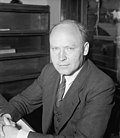 |
Carl-Gustaf Rossby | December 28, 1898 Stockholm, Sweden |
August 19, 1957 Stockholm, Sweden |
1957 | Nominated the only time by H.Pettersson.[390] Died before the only chance to be rewarded. |
| Gersh Budker | May 1, 1918 Murafa, near Vinnytsia, now Ukraine |
July 4, 1977 Akademgorodok, Russia |
1957 | [391] Nominated jointly with Vl.I.Veksler the only time by L.Ružička [392] | |
| Alexey Naumov | January 27, 1916 Petrograd, Russian Empire |
November 22, 1985 Protvino, Russia | |||
| Hans Busch | February 27, 1884 Jüchen, German Empire |
February 16, 1973 Darmstadt, Germany |
1957 | Nominated jointly with Ernst Ruska and M.Knoll only.[393] | |
| Clifford Charles Butler | May 20, 1922 Reading, Berkshire, United Kingdom |
June 30, 1999 Glenfield Hospital, England |
1957, 1958, 1959, 1961, 1962, 1963, 1964, 1965[am], 1966[am], 1967[am], 1968[am], 1969[am] | Nominated jointly with George Rochester only[394][395][bt] | |
| Brebis Bleaney | June 6, 1915 Chelsea, London, United Kingdom |
November 4, 2006 Oxford, England |
1957, 1959, 1966, 1971 | [396] | |
 |
Ettore Pancini | August 10, 1915 Stanghella, Kingdom of Italy |
September 2, 1981 Venice, Italy |
1957, 1963, 1972, 1973 | [397] Nominated jointly with M.Conversi only [398] |
| Oreste Piccioni | October 24, 1915 Siena, Kingdom of Italy |
April 13, 2002 Rancho Santa Fe, California, United States | |||
| Marcello Conversi | August 25, 1917 Tivoli, Lazio, Kingdom of Italy |
September 22, 1988 Rome, Italy |
1957, 1963, 1965, 1971, 1972, 1973, 1974 | [399] | |
 |
Yang Chen-Ning | October 1, 1922 Hefei, China |
1957[bu] | [400][bv] Shared the 1957 Nobel Prize in Physics[bw] [401] | |
 |
Tsung-Dao Lee | November 24, 1926 Shanghai, China |
August 4, 2024 San Francisco, California, United States |
1957[bu], 1958 | |
| 1958 | |||||
 |
Chien-Shiung Wu | May 31, 1912 Liuhe, Taicang, China |
February 16, 1997 New York City, United States |
1958, 1959, 1960, 1964, 1965, 1967[am], 1968, 1970, 1971, 1972, 1973, 1974 | [402][403][404][bx] |
 |
Robert Hofstadter | February 5, 1915 New York City, United States |
November 17, 1990 Stanford, California, United States |
1958, 1959, 1960, 1961 | Shared the 1961 Nobel Prize in Physics[by] with R.L.Mössbauer.[405] |
 |
Charles H. Townes | July 28, 1915 Greenville, South Carolina, United States |
January 27, 2015 Oakland, California, United States |
1958, 1959, 1960, 1961, 1962, 1963, 1964, 1965 | Shared the 1964 Nobel Prize in Physics with Al.M.Prokhorov and N.G.Basov[bz][406] |
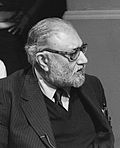 |
Abdus Salam | January 29, 1926 Jhang, now Pakistan |
November 21, 1996 Oxford, United Kingdom |
1958, 1966, 1967, 1968, 1969, 1970, 1971, 1972, 1973, 1974 | Shared the 1979 Nobel Prize in Physics with St.Weinberg and Sh.L.Glashow[ca][407][408] |
 |
Seymour Benzer | October 15, 1921 Bensonhurst, Brooklyn, New York, United States |
November 30, 2007 Pasadena, California, United States |
1958 | Nominated the only time by Ernest C. Pollard.[409] |
| Heinz Neuber [de] | November 22, 1906 Stettin, now Poland |
November 18, 1989 Bad Wörishofen, Germany |
1958 | Nominated the only time by Hajimu Ōkubo from Mechanical Engineering Department of Nagoya University.[410] | |
| Boris Rajewsky | July 17, 1893 Chyhyryn, now Ukraine |
November 22, 1974 Frankfurt am Main, Germany |
1958 | Nominated the only time by Fr.Dessauer.[411] | |
| Harold D. Babcock | January 24, 1882 Edgerton, Wisconsin, United States |
April 8, 1968 Pasadena, California, United States |
1958 | Nominated jointly with H.W.Babcock the only time by Al.H.G.Dauvillier[ay][412] | |
 |
Jan Korringa | March 31, 1915 Heemstede, Netherlands |
October 9, 2015 Laguna Beach, California, United States |
1958[cb] | [413][cc] |
| William Hume-Rothery | May 15, 1899 Worcester Park, United Kingdom |
September 27, 1968 Oxford, England |
1958 | Nominated the only time by G.D.Preston and for the Nobel Prize in Chemistry too.[414] | |
| Clyde Wiegand | May 23, 1915, Long Beach, Washington, United States |
July 5, 1996 Oakland, California, United States |
1958 | [415] Nominated jointly with Owen Chamberlain and Em.Segrè the only time by M.Verde [it] [416] | |
| Thomas Ypsilantis | June 24, 1928 Salt Lake City, United States |
August 15, 2000 Geneva, Switzerland | |||
 |
David Bohm | December 20, 1917 Wilkes-Barre, Pennsylvania, United States |
October 27, 1992 London, United Kingdom |
1958 | Nominated jointly with D.Pines the only time by Huzio Nakano [ja] (1922–2009) from Nagoya University.[417] |
| David Pines | June 8, 1924 Kansas City, Missouri, United States |
May 3, 2018 Urbana, Illinois, United States |
1958, 1968 | [418] | |
 |
Alfred Landé | December 13, 1888 Elberfeld, German Empire |
October 30, 1976 Columbus, Ohio, United States |
1958, 1969 | Nominated jointly with S.Goudsmit and G.Uhlenbeck by Alfred Kastler only.[419] |
| Jesse Beams | December 25, 1898 Belle Plaine, Kansas, United States |
July 23, 1977 Charlottesville, Virginia, United States |
1958, 1970 | [420] | |
 |
Victor Weisskopf | September 19, 1908 Vienna, Austria-Hungary |
April 22, 2002 Newton, Massachusetts, United States |
1958, 1965, 1967, 1969, 1970, 1971, 1973 | [421] |
 |
Yevgeny Zavoisky | September 28, 1907 Mohyliv-Podilskyi, now Ukraine |
October 9, 1976 Moscow, Russia |
1958, 1959, 1960, 1961, 1962, 1963, 1964, 1965, 1966, 1968, 1969, 1970, 1971, 1972, 1973, 1974 | Nominated for the Nobel Prize in Chemistry too.[422] |
| 1959 | |||||
 |
Donald A. Glaser | September 21, 1926 Cleveland, Ohio, United States |
February 28, 2013 Berkeley, California, United States |
1959, 1960 | Won the 1960 Nobel Prize in Physics[cd][423] |
 |
Leon M. Lederman | July 15, 1922 New York City, United States |
October 3, 2018 Rexburg, Idaho, United States |
1959, 1963, 1967, 1969 | Shared the 1988 Nobel Prize in Physics with M.Schwartz and J.Steinberger[ce][424] |
| Friedrich Dessauer | July 19, 1881 Aschaffenburg, German Empire |
February 16, 1963 Frankfurt am Main, Germany |
1959 | Nominated the only time by H.Schreiber [de] and for the Nobel Prize in Physiology or Medicine too[cf][425][426] | |
 |
Abram Ioffe | October 29, 1880 Romny, now Ukraine |
October 14, 1960 Leningrad, Russia |
1959 | Nominated the only time by Fr.X.Eder [de].[427] |
| Charles Kittel | July 18, 1916 New York City, United States |
May 15, 2019 Berkeley, California, United States |
1959 | Nominated the only time by W.Nierenberg.[428] | |
| Frank Philip Bowden | May 2, 1903 Hobart, Australia |
September 3, 1968 Cambridge, United Kingdom |
1959 | Nominated the only time by L.B.Loeb.[429] | |
 |
Nicholas Kemmer | December 7, 1911 Saint Petersburg, Russian Empire |
October 21, 1998 Edinburgh, United Kingdom |
1959, 1965 | [430] |
| J. D. Bernal | May 10, 1901 Nenagh, United Kingdom |
September 15, 1971 London, United Kingdom |
1959, 1966 | Nominated for the Nobel Prize in Chemistry too.[431] | |
| Frederick Charles Frank | March 6, 1911 Durban, South Africa |
April 5, 1998 Bristol, United Kingdom |
1959, 1961, 1968 | [432] | |
 |
Norbert Wiener | November 26, 1894 Columbia, Missouri, United States |
March 18, 1964 Stockholm, Sweden |
1959 | Nominated jointly with Cl.Shannon the only time by G. N. Ramachandran.[433] |
 |
Claude Shannon | April 30, 1916 Petoskey, Michigan, United States |
February 24, 2001 Medford, Massachusetts, United States |
1959, 1967, 1972, 1973 | [434] |
| Albrecht Unsöld | April 20, 1905 Bolheim, German Empire |
September 23, 1995 Kiel, Germany |
1959, 1973 | [435] | |
| Carl Wagner | May 25, 1901 Leipzig, German Empire |
December 10, 1977 Göttingen, Germany |
1959 | Nominated jointly with W.H.Schottky the only time by R.Vieweg [de] and for the Nobel Prize in Chemistry too.[436] | |
 |
Walter H. Schottky | July 23, 1886 Zürich, Switzerland |
March 4, 1976 Pretzfeld, Germany |
1959, 1965, 1967[am], 1973, 1974 | Nominated for the Nobel Prize in Chemistry too.[437] |
| André Lallemand | September 29, 1904 Cirey-lès-Pontailler, France |
March 24, 1978 Paris, France |
1959, 1960, 1961, 1962, 1964, 1971, 1974 | [438] | |
| Nikolay Bogolyubov | August 21, 1909 Nizhny Novgorod, Russian Empire |
February 13, 1992 Moscow, Russia |
1959, 1960, 1963, 1966, 1967, 1968, 1969, 1970, 1971, 1972, 1973, 1974 | Nominated for the Nobel Prize in Chemistry too[439][440] | |
Close
1960–1969
More information Picture, Name ...
| Picture | Name | Born | Died | Years Nominated | Notes |
|---|---|---|---|---|---|
| 1960 | |||||
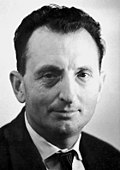 |
Alexander Prokhorov | July 11, 1916 Peeramon, Queensland, Australia |
January 8, 2002 Moscow, Russia |
1960, 1962, 1963, 1964 | [441] Shared the 1964 Nobel Prize in Physics with Ch.H.Townes[bz] [442] |
 |
Nikolay Basov | December 14, 1922 Usman, Russian Empire |
July 1, 2001 Moscow, Russia | ||
 |
Murray Gell-Mann | September 15, 1929 Manhattan, New York City, United States |
May 24, 2019 Santa Fe, New Mexico, United States |
1960, 1961, 1964, 1965, 1966, 1967, 1968, 1969 | Won the 1969 Nobel Prize in Physics[cg][443] |
 |
Abraham Pais | May 19, 1918 Amsterdam, Netherlands |
July 28, 2000 Copenhagen, Denmark |
1960, 1968 | Nominated jointly with M.Gell-Mann only.[444] |
 |
Nicolaas Bloembergen | March 11, 1920 Dordrecht, Netherlands |
September 5, 2017 Tucson, Arizona, United States |
1960, 1962, 1963, 1969, 1972, 1973, 1974 | Shared the 1981 Nobel Prize in Physics with A.L.Schawlow[ch] and K.M.B.Siegbahn.[445] |
 |
Max Perutz | May 19, 1914 Vienna, Austria-Hungary |
February 6, 2002 Cambridge, United Kingdom |
1960, 1961 | [446] Shared the 1962 Nobel Prize in Chemistry [447] |
 |
John Kendrew | March 24, 1917 Oxford, United Kingdom |
August 23, 1997 Cambridge, England | ||
| Jean Brossel | August 15, 1918 Périgueux, France |
February 4, 2003 Périgueux, France |
1960, 1965, 1966 | Nominated jointly with Alfred Kastler only.[448] | |
 |
Albert Overhauser | August 17, 1925 San Diego, California, United States |
December 10, 2011 West Lafayette, Indiana, United States |
1960, 1963, 1968 | Nominated jointly with An.Abragam only.[449] |
 |
Anatole Abragam | December 15, 1914 Griva, now Latvia |
June 8, 2011 Paris, France |
1960, 1963, 1968, 1970, 1971, 1974 | [450] |
 |
James Van Allen | September 7, 1914 Mount Pleasant, Iowa, United States |
August 9, 2006 Iowa City, Iowa, United States |
1960, 1961, 1962, 1965, 1967, 1968, 1969, 1970, 1971, 1973, 1974 | [451] |
 |
Kazuhiko Nishijima | October 4, 1926 Tsuchiura, Japan |
February 15, 2009 Tokyo, Japan |
1960, 1961, 1964, 1966, 1967, 1968, 1969, 1970 | [452] |
| 1961 | |||||
| Tadao Nakano [ja] (Japanese: 中野 董夫) |
1926 Tokyo, Japan |
August 15, 2004 Takatsuki, Japan |
1961, 1970 | Nominated jointly with K.Nishijima only.[453] | |
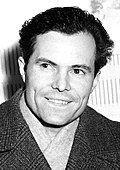 |
Rudolf Mössbauer | January 31, 1929 Munich, Germany |
September 14, 2011 Grünwald, Bavaria, Germany |
1961 | Shared the 1961 Nobel Prize in Physics[ci] with R.Hofstadter.[454] |
 |
Leon Cooper | February 28, 1930 Bronx, New York, United States |
October 23, 2024 Providence, Rhode Island, U.S. |
1961, 1963, 1965, 1966, 1967, 1968, 1969, 1970, 1971, 1972 | [455] Shared the 1972 Nobel Prize in Physics with J.Bardeen[bj] [456] |
 |
John Robert Schrieffer | May 31, 1931 Oak Park, Illinois, United States |
July 27, 2019 Tallahassee, Florida, United States | ||
 |
Aage Bohr | June 19, 1922 Copenhagen, Denmark |
September 8, 2009 Copenhagen, Denmark |
1961, 1965, 1966, 1967, 1968, 1969, 1970, 1971, 1972, 1973, 1974 | [457][458] Shared the 1975 Nobel Prize in Physics with J.Rainwater[cj] [459] |
 |
Ben Roy Mottelson | July 9, 1926 Chicago, United States |
May 13, 2022 Copenhagen, Denmark | ||
| Louis Harold Gray | November 10, 1905 London Borough of Richmond upon Thames, United Kingdom |
July 9, 1965 Northwood, London, England |
1961 | Nominated the only time by H.E.Johns.[460] | |
| Ladislaus L. (Bill) Marton [pt] | August 15, 1901 Budapest, Austria-Hungary |
January 22, 1979 Washington, D.C., United States[461] |
1961 | Nominated jointly with Ernst Ruska and M.Knoll the only time by D.Gabor.[462] | |
 |
Frederick Seitz | July 4, 1911 San Francisco, United States |
March 2, 2008 New York City, United States |
1961 | Nominated jointly with N.Fr.Mott the only time by Kurt Lücke (1921–2001) from RWTH Aachen University.[463] |
 |
Walter Heitler | January 2, 1904 Karlsruhe, German Empire |
November 15, 1981 Zollikon, Switzerland |
1961, 1962, 1963, 1964, 1965, 1966, 1967, 1969, 1970, 1971, 1973, 1974 | Nominated for the Nobel Prize in Chemistry too.[464] |
| Egon Orowan | August 2, 1902 Óbuda, Austria-Hungary |
August 3, 1989 Cambridge, United Kingdom |
1961, 1968, 1970, 1973, 1974 | Nominated jointly with G. I. Taylor only[465][466] | |
 |
Michael Polanyi | March 11, 1891 Budapest, Austria-Hungary |
February 22, 1976 Northampton, United Kingdom |
1961, 1968, 1970, 1973, 1974 | Nominated jointly with G. I. Taylor and Egon Orowan only and for the Nobel Prize in Chemistry too.[467] |
| 1962 | |||||
| Nikolay V. Belov | December 14, 1891 Janów Lubelski, Congress Poland |
March 6, 1982 Moscow, Russia |
1962 | Nominated the only time by his chief A.V.Subnikov and for the Nobel Prize in Chemistry too.[468] | |
| Bogdan Maglich | August 5, 1928, Sombor, now Serbia |
November 25, 2017 Newport Beach, California, United States |
1962 | Nominated the only time by Sreten Šljivić (1899–1974) from University of Belgrade.[469] | |
| Reinhold Rudenberg | February 4, 1883 Hannover, German Empire |
December 25, 1961 Boston, United States |
1962 | Posthumously nominated the only time by P.W.Bridgman.[470] | |
| Francis Bitter | July 22, 1902 Weehawken, New Jersey, United States |
July 26, 1967 Cape Cod Hospital, Hyannis, Massachusetts, United States |
1962 | Nominated jointly with Alfred Kastler and Ch.H.Townes the only time by Fr.Seitz.[471] | |
| Martin Näbauer [de] | November 1, 1919 Karlsruhe, Germany |
September 10, 1962 Munich, Germany |
1962 | Nominated with R.Doll [de] the only time by W.Meissner.[472] Died before the only chance to be rewarded. | |
| R.Doll [de] | January 16, 1923 Munich, Germany |
April 13, 2018 Munich, Germany |
1962, 1963 | [473] | |
| Marian Danysz | March 17, 1909 Paris, France |
February 9, 1983 Warsaw, Poland |
1962, 1965, 1967, 1971, 1972, 1973, 1974 | [474] | |
 |
Theodore Maiman | July 11, 1927 Los Angeles, California, United States |
May 5, 2007 Vancouver, Canada |
1962, 1969 | [475] |
 |
Ali Javan | December 26, 1926 Tehran, Iran |
September 12, 2016 Los Angeles, California, United States |
1962, 1963, 1973 | [476] |
 |
Joseph Weber | May 17, 1919 Paterson, New Jersey, United States |
September 30, 2000 Pittsburgh, United States |
1962, 1963, 1970, 1971, 1973, 1974 | [477][478] |
| 1963 | |||||
 |
James P. Gordon | March 20, 1928 New York City, United States |
June 21, 2013 Manhattan, New York City, United States |
1963 | Nominated jointly with Ch.H.Townes the only time by G.Bernardini [it].[479] |
 |
Bernard Lovell | August 31, 1913 Oldland Common, United Kingdom |
August 6, 2012 Swettenham, England |
1963, 1964, 1965, 1966, 1967, 1968, 1969, 1970, 1971, 1972, 1973, 1974 | Nominated jointly with M.Ryle only.[480][481] |
| Martin Ryle | September 27, 1918 Brighton, United Kingdom |
October 14, 1984 Cambridge, England |
1963, 1964, 1965, 1966, 1967, 1968, 1969, 1970, 1971, 1972, 1973, 1974 | Shared the 1974 Nobel Prize in Physics with Ant.Hewish[ck].[482] | |
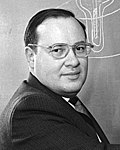 |
Arthur Leonard Schawlow | May 5, 1921 Mount Vernon, New York, United States |
April 28, 1999 Palo Alto, California, United States |
1963, 1964, 1969 | Shared the 1981 Nobel Prize in Physics with N.Bloembergen[ch] and K.M.B.Siegbahn[483][484] |
| Melvin Schwartz | November 2, 1932 New York City, United States |
August 28, 2006 Twin Falls, Idaho, United States |
1963, 1964, 1966, 1967, 1968, 1969, 1971, 1973, 1974 | [485] Shared the 1988 Nobel Prize in Physics with L.M.Lederman[cl] [486] | |
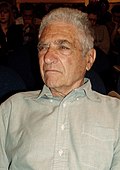 |
Jack Steinberger | May 25, 1921 Bad Kissingen, Germany |
December 12, 2020 Geneva, Switzerland |
1963, 1967, 1969, 1971, 1974 | |
 |
Max Delbrück | September 4, 1906 Berlin, German Empire |
March 9, 1981 Pasadena, California, United States |
1963 | Shared the 1969 Nobel Prize in Physiology or Medicine with Alfred Hershey and S.Luria.[487] |
 |
Walter Friedrich | December 25, 1883 Salbke, Magdeburg, German Empire |
October 16, 1968 Berlin, Germany |
1963 | Nominated the only time by Fr.Kirchner [de].[488] |
| Adriano Gozzini | April 13, 1917 Florence, Kingdom of Italy |
September 24, 1994 Pisa, Italy |
1963, 1965, 1971 | Nominated jointly with M.Conversi only.[489] | |
| Herbert Fröhlich | December 9, 1905 Rexingen, German Empire |
January 23, 1991 Liverpool, United Kingdom |
1963, 1964, 1966, 1970, 1972 | [490] | |
| William M. Fairbank | February 24, 1917 Minneapolis, United States |
September 30, 1989 Palo Alto, California, United States |
1963, 1969, 1970, 1971, 1973 | [491] | |
| Ernest Courant | March 26, 1920 Göttingen, Germany |
April 21, 2020 Ann Arbor, United States |
1963, 1967, 1971, 1973, 1974 | [492] Jointly nominated only [493] | |
| M. Stanley Livingston | May 25, 1905 Brodhead, Wisconsin, United States |
August 25, 1986 Santa Fe, New Mexico, United States | |||
| 1964 | |||||
 |
Philip Burton Moon | May 17, 1907 Lewisham, United Kingdom |
October 9, 1994 Worcester, England, |
1964 | Nominated the only time by R.L.Mössbauer.[494] |
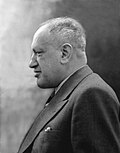 |
Leopold Infeld | August 20, 1898 Kraków, now Poland |
January 15, 1968 Warsaw, Poland |
1964 | Nominated the only time by H.Hönl.[495] |
| Keith Edward Bullen | June 29, 1906 Auckland, New Zealand |
September 23, 1976 Auckland, New Zealand |
1964 | Nominated jointly with H.Jeffreys the only time by Al.Zátopek [cs].[496] | |
| Hermann Schüler [de] | July 24, 1894 Posen, now Poland |
July 5, 1964 Göttingen, Germany |
1964 | [497] Nominated jointly the only time by Karl Walter Kofink (1907–1977) from Karlsruhe Institute of Technology Schüler has died before the only chance to be rewarded[498] | |
| Theodor Schmidt [de] | July 29, 1908 Düsseldorf, German Empire |
December 10, 1986 Sulzburg, Germany | |||
 |
Scott Forbush | April 10, 1904 Hudson, Ohio, United States |
April 4, 1984 Charlottesville, Virginia, United States |
1964, 1968 | Nominated by J.Al.Simpson only.[499] |
 |
Edoardo Amaldi | September 5, 1908 Carpaneto Piacentino, Kingdom of Italy |
December 5, 1989 Rome, Italy |
1964, 1971, 1974 | [500] |
 |
Freeman Dyson | December 15, 1923 Crowthorne, United Kingdom |
February 28, 2020 Princeton, New Jersey, United States |
1964, 1971, 1972, 1973, 1974 | [501] |
 |
William Alfred Fowler | August 9, 1911 Pittsburgh, United States |
March 14, 1995 Pasadena, California, United States |
1964, 1972, 1973, 1974 | Shared the 1983 Nobel Prize in Physics[cm] with S.Chandrasekhar.[502] |
| Geoffrey Burbidge | September 24, 1925 Chipping Norton, United Kingdom |
January 26, 2010 La Jolla, California, United States |
1964 | Nominated jointly with his wife M/Burbidge, W. Alfred Fowler and Fr.Hoyle the only time by H.Cl.Urey[503] | |
| Margaret Burbidge | August 12, 1919 Davenport, Greater Manchester, United Kingdom |
April 5, 2020 San Francisco, United States |
1964, 1973 | [504][505] | |
 |
Fred Hoyle | June 24, 1915 Gilstead, Bingley, West Riding of Yorkshire, United Kingdom |
August 20, 2001 Bournemouth, England |
1964, 1965, 1970, 1973 | [506] |
| 1965 | |||||
| Martin Schwarzschild | May 31, 1912 Potsdam, German Empire |
April 10, 1997 Langhorne, Pennsylvania, United States |
1965 | Nominated jointly with Fr.Hoyle the only time by William Russell Hindmarsh[507] (1929–1973) from Newcastle upon Tyne.[508] | |
| Sybren de Groot [nl] | April 18, 1916 Amsterdam, Netherlands |
May 9, 1994 Amsterdam, Netherlands |
1965 | Nominated the only time by H.Ziegler from ETH Zurich.[509] | |
| Susumu Okubo | March 2, 1930 Tokyo, Japan |
July 17, 2015 Rochester, New York, United States |
1965 | Nominated the only time by R.E.Marshak.[510] | |
| Jan Volger[511] | November 18, 1919 Haarlem, Netherlands |
December 25, 1984[512] | 1965 | Nominated the only time by Otto Haxel.[513] | |
| Yoshio Ohnuki [ja] | November 7, 1928 Tochigi Prefecture, Japan |
1965, 1966[cn] | Nominated jointly with M.Gell-Mann and Y.Ne'eman by G.Sutherland only.[514][co] | ||
 |
Yuval Ne'eman | May 14, 1925 Tel Aviv, Mandatory Palestine |
April 26, 2006 Tel Aviv, Israel |
1965, 1966[cn], 1967, 1969 | Nominated jointly with M.Gell-Mann only[515] |
 |
Friedrich Hund | February 4, 1896 Karlsruhe, German Empire |
March 31, 1997 Göttingen, Germany |
1965, 1969 | Nominated jointly with Er.Hückel only and for the Nobel Prize in Chemistry too.[516] |
 |
Erich Hückel | August 9, 1896, Berlin Berlin, German Empire |
February 16, 1980 Marburg, Germany |
1965, 1966, 1969 | Nominated for the Nobel Prize in Chemistry too.[517] |
 |
Nicholas Christofilos | December 16, 1916 Boston, Massachusetts, United States |
September 24, 1972 Hayward, California, United States |
1965, 1967, 1971 | [518] |
 |
Jerzy Pniewski | June 1, 1913 Płock, Congress Poland |
June 16, 1989 Warsaw, Poland |
1965, 1967, 1971, 1972, 1973, 1974 | Nominated jointly with M.Danysz only.[519] |
 |
Maurice Françon | June 15, 1913 Paris, France |
August 11, 1996 Sallanches, France |
1965, 1974 | [520][521] |
 |
Robert Hanbury Brown | August 31, 1916 Aruvankadu, India |
January 16, 2002 Andover, Hampshire, England |
1965, 1966, 1973, 1974 | [522] |
| Richard Q. Twiss | August 24, 1920 Shimla, India |
May 20, 2005 Sydney, Australia |
1965, 1966, 1974 | Nominated jointly with R.H.Brown only[523] | |
 |
John Archibald Wheeler | July 9, 1911 Jacksonville, Florida, United States |
April 13, 2008 Hightstown, New Jersey, United States |
1965, 1967, 1968, 1969, 1970, 1971, 1972, 1973, 1974 | [524][525] |
| 1966 | |||||
 |
Dennis Gabor | June 5, 1900 Budapest, Austria-Hungary |
February 9, 1979 London, United Kingdom |
1966, 1967, 1968, 1969, 1970, 1971, 1972 | Won the 1971 Nobel Prize in Physics[cp] and nominated for the Nobel Prize in Physiology or Medicine too.[cq][526] |
 |
James Cronin | September 29, 1931 Chicago, United States |
August 25, 2016 Saint Paul, Minnesota, United States |
1966, 1967, 1968, 1969, 1970, 1971, 1972, 1973, 1974 | [527][528] Shared the 1980 Nobel Prize in Physics[cr] [529] |
 |
Val Logsdon Fitch | March 10, 1923 Merriman, Nebraska, United States |
February 5, 2015 Princeton, New Jersey, United States | ||
 |
Bertram Brockhouse | July 15, 1918 Lethbridge, Alberta, Canada |
October 13, 2003 Hamilton, Ontario, Canada |
1966, 1969, 1971, 1972, 1974 | Shared the 1994 Nobel Prize in Physics[cs] with Cl.Shull.[530] |
| H. Richard Crane | November 4, 1907 Turlock, California, United States |
April 19, 2007 Ann Arbor, Michigan, United States |
1966 | [531] | |
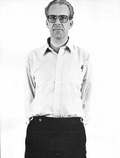 |
Maarten Schmidt | December 28, 1929 Groningen, Netherlands |
September 17, 2022 Pasadena, California, United States |
1966 | [532] |
| William Brownfield Fowler[533] | March 22, 1924 Owensboro, Kentucky, United States |
May 3, 2015 St. Charles, Illinois, United States |
1966 | [534] Nominated jointly the only time by Th.G.Kouyoumzelis [el] [535] | |
| Nicholas P. Samios | March 15, 1932 New York City, United States |
||||
| Jack Warren Keuffel[536] | May 10, 1919 |
May 23, 1974 Little Cottonwood Canyon, United States |
1966 | [537] [538] Nominated jointly[539] the only time by Yozo Nogami (1918–2008) from University of Tokyo [540] [541] [542] | |
| Thomas Edwin Cranshaw[543] | March 8, 1922 St.Annes-on-Sea, Fylde, United Kingdom |
January 14, 2016 | |||
| Johannes Frederik ("Hannes") de Beer[544] | 1930 |
||||
 |
Shuji Fukui [ja] | August 19, 1923 Osaka, Japan |
May 4, 2018 Japan | ||
| Sigenori Miyamoto[545] | October 20, 1931 Akashi, Hyōgo, Japan |
December 31, 2017 Japan | |||
| Dan Schneiderman | 1922 Baltimore, United States |
December 22, 2007 Pasadena, California, United States[546] |
1966 | [547] [548] Nominated jointly[549] with R.B.Leighton the only time by R.L.F.Boyd [550] [551] [552] | |
| Richard Kanne Sloan | November 11, 1930 Hockessin, Delaware, United States |
||||
| J. Denton Allen | May 16, 1934 |
April 5, 2014 Pasadena, California, United States[553] | |||
 |
Bruce C. Murray | November 30, 1931 New York City, United States |
August 29, 2013 Oceanside, California, United States | ||
| Robert P. Sharp | June 24, 1911 Oxnard, California, United States |
May 24, 2004 Santa Barbara, California, United States | |||
| Robert B. Leighton | September 10, 1919 Detroit, United States |
March 9, 1997 Pasadena, California, United States |
1966, 1970 | [554] | |
 |
Jacques Friedel | February 11, 1921 Paris, France |
August 27, 2014 Paris, France |
1966, 1972 | [555] |
 |
Bernd T. Matthias | June 8, 1918 Frankfurt am Main, German Empire |
October 27, 1980 La Jolla, California, United States |
1966, 1967, 1969, 1970, 1971, 1972 | Nominated for the Nobel Prize in Chemistry too.[556] |
| Brian Pippard | September 7, 1920 Earl's Court, London, United Kingdom |
September 21, 2008 Cambridge, England |
1966, 1970, 1972, 1973 | [557] Jointly nominated only [558] | |
| David Shoenberg | January 4, 1911 Saint Petersburg, Russian Empire |
March 10, 2004 Cambridge, United Kingdom | |||
| Vladimir Fock | December 22, 1898 Saint Petersburg, Russian Empire |
December 27, 1974 Leningrad, Russia |
1966, 1971, 1972, 1973, 1974 | [559] | |
| 1967 | |||||
| Vladimir Vladimirovich Belousov | October 30, 1907 Moscow, Russian Empire |
December 25, 1990 Moscow, Russia |
1967 | Nominated the only time by Robert Lauterbach [de].[560] | |
| Arnold 'Fritz' Bopp | December 27, 1909 Frankfurt, German Empire |
November 14, 1987 Munich, Germany |
1967 | Nominated the only time by Gerhard Fanselau.[561] | |
| Stuart Thomas Butler | July 4, 1926 Naracoorte, South Australia, Australia |
May 15, 1982 Lucas Heights, New South Wales, Australia |
1967 | Nominated the only time by Joseph Lafoucrière (1918–2008) from Lyon.[562] | |
 |
Hartmut Kallmann | February 5, 1896 Berlin, German Empire |
June 11, 1978 Munich, Germany |
1967[ct] | [563][cu] |
| James Stanley Hey | May 3, 1909 Nelson, Lancashire, United Kingdom |
February 27, 2000 |
1967 | Nominated jointly with Gr.Reber the only time by Satya Narayan from Hyderabad.[564] | |
| Albert Rose | March 30, 1910 New York City, United States |
July 26, 1990 Princeton, New Jersey, United States |
1967 | [565] Nominated jointly the only time by Georges Asch (1931–2018) from the University Lyon 1 [566] | |
| Murray A. Lampert[567] | 1921 New York City, United States |
August 4, 1988 Princeton, New Jersey, United States | |||
 |
Bruno Pontecorvo | August 22, 1913 Marina di Pisa, Kingdom of Italy |
September 24, 1993 Dubna, Russia |
1967 | Nominated jointly with M.Schwartz and L.W.Alvarez the only time by R.Hofstadter.[568] |
 |
Edward Uhler Condon | March 2, 1902 Alamogordo, New Mexico, United States |
March 26, 1974 Boulder, Colorado, United States |
1967 | Nominated jointly with J.R.Oppenheimer and G.Gamow the only time by Alb.All.Bartlett.[569] |
| Rudolf Hilsch [de] | December 18, 1903 Hamburg, German Empire |
May 29, 1972 Göttingen, Germany |
1967[am] | Nominated jointly with R.W.Pohl and W.H.Schottky the only time by Hans-Ulrich Harten (1920–1998) from the University of Göttingen.[570] | |
| Gerhart Lüders | February 25, 1920 Hamburg, Germany |
January 31, 1995 Göttingen, Germany |
1967[am] | Nominated the only time by F.Fr.Cap [de].[571][cv] | |
| Cormac Ó Ceallaigh | July 29, 1912 Dublin, United Kingdom of Great Britain and Ireland |
October 10, 1996 Dublin, Ireland |
Nominated jointly with Louis Leprince-Ringuet the only time by F.Fr.Cap [de].[572][cw] | ||
| Rafael Armenteros | 1922 |
March 5, 2004 |
Nominated jointly with Cl.Ch.Butler and G.D.Rochester the only time by F.Fr.Cap [de].[573][cx] | ||
| Gordon Thompson Danby | November 8, 1929 Richmond, Ontario, Canada |
August 2, 2016 Stony Brook, New York, United States |
Nominated jointly with co-workers the only time by F.Fr.Cap [de].[574][cy] | ||
| Isaak Yakovlevich Pomeranchuk | May 20, 1913 Warsaw, Congress Poland |
December 14, 1966 Moscow, Russia |
Posthumously nominated jointly with G.F.Chew the only time by F.Fr.Cap [de].[575][cz] | ||
 |
Geoffrey Foucar Chew | June 5, 1924 Washington, D.C., United States |
April 12, 2019 Berkeley, California, United States |
1967[am], 1972, 1974 | [576] |
 |
Hermann Julius Oberth | June 25, 1894 Nagyszeben (Hermannstadt), now Romania |
December 28, 1989 Nuremberg, Germany |
1967[am], 1971, 1972 | [577] |
| Tullio Eugenio Regge | July 11, 1931 Borgo d'Ale, Kingdom of Italy |
October 23, 2014 Orbassano, Italy |
1967[am], 1973 | [578] | |
 |
Marvin Leonard "Murph" Goldberger | October 22, 1922 Chicago, United States |
November 26, 2014 La Jolla, United States |
1967[am], 1972, 1973, 1974 | [579][580] |
| David Warren Turner | July 16, 1927 Leigh-on-Sea, United Kingdom |
1967, 1968, probably 1969&1970[da] | Nominated by E.Lindholm [sv] only and for the Nobel Prize in Chemistry too[581][db] | ||
 |
Raimond Castaing | December 28, 1921 Monaco |
April 10, 1998 Clamart, France |
1967, 1972, 1974 | Nominated for the Nobel Prize in Chemistry too[582][583] |
 |
Harrie Stewart Wilson Massey | May 16, 1908 Invermay, Victoria, Australia |
November 27, 1983 Esher, United Kingdom |
1967, 1969, 1973, 1974 | [584] |
 |
Rudolf Ernst Peierls | June 5, 1907 Berlin, German Empire |
September 19, 1995 Oxford, United Kingdom |
1967, 1969, 1970, 1971, 1972, 1973, 1974 | [585][586] |
| 1968 | |||||
 |
Leo Esaki | March 12, 1925 Takaida-mura, Nakakawachi-gun, Osaka Prefecture, Japan |
1968[dc] | [587][dd] Shared the 1973 Nobel Prize in Physics[de] [588][df] [dg][589][dh] | |
 |
Ivar Giaever | April 5, 1929 Bergen, Norway |
June 20, 1925 Schenectady, New York, United States | ||
 |
Brian Josephson | January 4, 1940 Cardiff, United Kingdom |
1968, 1969, 1970[di] | ||
| Robert Edward Bell | November 29, 1918 New Malden, United Kingdom |
April 1, 1992 Vancouver, Canada |
1968 | Nominated the only time by Nalini Kanta Saha (1908–199?) from the Delhi University.[590] | |
| Gaston Dupouy [fr] | August 7, 1900 Marmande, France |
October 22, 1985 Toulouse, France |
1968 | [591] | |
| William Elisworth Gifford[592] | June 20, 1919 Cleveland, United States |
1980 Syracuse, New York, United States |
1968 | Nominated the only time by Osmund Dorenfeldt Jenssen (1923–2009) from University of Trondheim.[593] | |
 |
John Eugene Kunzler[594] | April 25, 1923 Willard, Utah, United States |
January 11, 2006 Port Murray, New Jersey, United States |
1968 | Nominated the only time by P.E.Duwez from Caltech.[595] |
| George J. Schulz [de] | April 29, 1925 Brno, now Czechia |
January 15, 1976 New Haven, Connecticut, United States |
1968 | Nominated the only time by R.Kollath [de] and nominated for the Nobel Prize in Chemistry too[596] | |
| Hiroomi Umezawa | September 20, 1924 Kurihashi, Saitama, Japan |
March 24, 1995 Edmonton, Alberta, Canada |
1968 | Nominated the only time by Ed.R.Caianiello and nominated for the Nobel Prize in Chemistry too[597] | |
 |
Konrad Ernst Otto Zuse | June 22, 1910 Wilmersdorf, German Empire |
December 18, 1995 Hünfeld, Germany |
1968 | Nominated the only time by H.Ehrenberg [de].[598] |
| Sergei Vernov | July 11, 1910 Sestroretsk, Russian Empire |
May 29, 1972 Moscow, Russia |
1968 | Nominated jointly with H.Alfvén, S.Chapman and J.Alfr.Van Allen the only time by L.Harang.[599] | |
 |
Ivar Waller | June 11, 1898 Flen, Sweden |
April 12, 1991 Uppsala, Sweden |
1968, 1971, 1973 | Nominated jointly with C.J.Gorter only.[600] |
| Herman Francis Mark | May 3, 1895 Vienna, Austria |
April 6, 1992 Austin, Texas, United States |
1968, 1970, 1972, 1973 | Nominated by R.Robinson only and for the Nobel Prize in Chemistry too.[601][602] | |
| Gerhard Borrmann | April 30, 1908 Diedenhofen, now France |
April 12, 2006 Braunfels, Germany |
1968 | Nominated jointly with P.P.Ewald the only time by G.Leibfried [de].[603] | |
| Paul Peter Ewald | January 23, 1888 Berlin, German Empire |
August 22, 1985 Ithaca, New York, United States |
1968, 1970, 1974 | [604] | |
| Jeffrey Goldstone | September 3, 1933 Manchester, United Kingdom |
1968[dj], 1969[dj], 1970[dj] | [605][dk] Nominated by W.Heisenberg only [606] | ||
 |
Hans-Peter Dürr | October 7, 1929 Stuttgart, Germany |
May 18, 2014 Munich, Germany |
1968[dj], 1969[dj], 1970[dj], 1974 | |
| Robert Henry Dicke | May 6, 1916 St. Louis, Missouri, United States |
March 4, 1997 Princeton, New Jersey, United States |
1968, 1969, 1971, 1974 | [607] | |
 |
John Clarke Slater | December 22, 1900 Oak Park, Illinois, United States |
July 25, 1976 Sanibel Island, Florida, United States |
1968, 1969, 1970, 1971, 1972, 1973, 1974 | Nominated for the Nobel Prize in Chemistry too.[608] |
| 1969 | |||||
 |
CERN | Established in 1954 Geneva, Switzerland |
1969 | Nominated the only time by A.K.M.Kinani from Damascus.[609] | |
| John Battiscombe "J. B." Gunn |
May 13, 1928 Cairo, Egypt |
December 2, 2008 Mount Kisco, New York, United States |
1969 | Nominated the only time by Ernst Jenő [hu] from the Pécs University Medical School.[610] | |
| Jens Lindhard | February 26, 1922 Tystofte, Tjæreby Sogn, Denmark |
October 17, 1997 |
1969 | Nominated the only time by M.F.Yeniçay.[611] | |
| Reginald Charles Rainey | June 18, 1913 Gosport, United Kingdom |
January 18, 1990 |
1969 | Nominated the only time by R.S.Scorer.[612] | |
 |
Nicola Cabibbo | April 10, 1935 Rome, Kingdom of Italy |
August 16, 2010 Rome, Italy |
1969 | Nominated jointly with M.Gell-Mann the only time by M.J.G.Veltman.[613] |
| Jacob G. Dorfman [ru] | March 26, 1898 Saint Petersburg, Russian Empire |
November 5, 1976 Leningrad, Russia |
1969 | Nominated jointly with Ye.K.Zavoisky the only time by Yu.B.Khariton.[614] | |
 |
Eugene Newman Parker | June 10, 1927 Houghton, Michigan, United States |
March 15, 2022 Chicago, United States |
1969 | Nominated jointly with H.Ol.G.Alfvén and J.Alfr.Van Allen the only time by D.W.Kerst.[615] |
 |
Emmett Norman Leith | March 12, 1927 Detroit, United States |
December 23, 2005 Ann Arbor, Michigan, United States |
1969 | [616] Nominated jointly with D.Gabor the only time by Günther Porod [617] |
| Juris Upatnieks | May 7, 1936 Riga, Latvia |
||||
| Feza Gürsey | April 7, 1921 Istanbul, Turkey |
April 13, 1992 New Haven, Connecticut, United States |
1969 | [618] Nominated jointly with M.Gell-Mann the only time by Ahmet İhsan Özdogan (1913–1993) from the Department of Geophysical Engineering of Istanbul University [619] | |
 |
Luigi Arialdo Radicati di Brozolo | October 12, 1919 Milano, Kingdom of Italy |
August 23, 2019 Pisa, Italy | ||
| Sven Algot Joel Liljendahl | June 12, 1912 Halland County, Sweden |
2000 | 1969 | Nominated jointly with Jens Leif Løkka (1913–1980)[620] from Mysen, Norway and K Kondō the only time by Osm.D.Jenssen[dl][621] | |
| Jens Leif Løkka | July 1, 1913 | 1980 | 1969, 1970 | Nominated by Osm.D.Jenssen[dl] only.[620] | |
| Robert William Terhune[622] | February 7, 1926 Detroit, United States |
November 20, 2014 Blacksburg, Virginia, United States |
1969 | [623] Nominated jointly with P.A.Franken the only time by Gianfranco Chiarotti (1928–2017) from the Sapienza University of Rome [624] | |
| Joseph Anthony Giordmaine [de] | April 10, 1933 Toronto, Canada |
||||
 |
Peter Alden Franken | November 10, 1928 | March 11, 1999 Tucson, Arizona, United States |
1969, 1972 | [625] |
 |
Georgy Nikolayevich Flerov | March 2, 1913 Rostov-on-Don, Russian Empire |
November 19, 1990 Moscow, Russia |
1969, 1970, 1972 | Nominated for the Nobel Prize in Chemistry too.[626] |
 |
Pierre Jacquinot | January 18, 1910 Frouard, France |
September 22, 2002 Paris, France |
1969, 1972, 1973 | [627][628] |
 |
Jun Kondō | February 6, 1930 Tokyo, Japan |
March 11, 2022 Suginami, Japan |
1969, 1972, 1974 | [629][630] |
Close
1970–
More information Picture, Name ...
| Picture | Name | Born | Died | Years Nominated | Notes |
|---|---|---|---|---|---|
| 1970 | |||||
 |
Antony Hewish | May 11, 1924 Fowey, United Kingdom |
September 13, 2021 | 1970, 1971, 1972, 1973, 1974 | Shared the 1974 Nobel Prize in Physics with M.Ryle[ck][631][632] |
 |
Dame Susan Jocelyn Bell Burnell | July 15, 1943 Lurgan, United Kingdom |
1970[dm] | [633][dn] | |
 |
Arno Allan Penzias | April 26, 1933 Munich, Germany |
January 22, 2024 San Francisco, United States |
1970, 1974 | [634] Shared the 1978 Nobel Prize in Physics[do] with P.L.Kapitsa [635][636] |
 |
Robert Woodrow Wilson | January 10, 1936 Houston, Texas, United States |
|||
 |
Kai Manne Börje Siegbahn | April 20, 1918 Lund, Sweden |
July 20, 2007 Ängelholm, Sweden |
1970, 1971, 1973, 1974 | Shared the 1981 Nobel Prize in Physics[dp] with N.Bloembergen and A.L.Schawlow and nominated for the Nobel Prize in Chemistry too.[637] |
| Carl Nordling | February 6, 1931 | April 1, 2016 | 1970, 1974 | Nominated jointly with K.M.B.Siegbahn only by Gunnar Bäckström from the Umeå University and nominated for the Nobel Prize in Chemistry too.[638] | |
 |
Alexei Alexeyevich Abrikosov | June 25, 1928 Moscow, Russia |
March 29, 2017 Palo Alto, United States |
1970[dq], 1971, 1974 | Shared the 2003 Nobel Prize in Physics with V.L.Ginzburg and Anth.J.Leggett[dr][639] |
| Paul Gaston Bastien[640] | May 26, 1907 Fontenay-le-Comte, France |
April 26, 1982 Paris, France |
1970 | Nominated the only time by G.Homès from Brussels.[641] | |
 |
Edward Teller | January 15, 1908 Budapest, Austria-Hungary |
September 9, 2003 Stanford, California, United States |
1970 | Nominated the only time by Or.Piccioni and for the Nobel Prize in Chemistry too.[642] |
| William Houlder "Willie" Zachariasen |
February 5, 1906 Langesund, Norway |
December 24, 1979 Santa Fe, New Mexico, United States |
1970 | Nominated the only time by B.T.Matthias.[643] | |
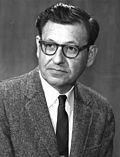 |
Albert Ghiorso | July 15, 1915 Vallejo, California, United States |
December 26, 2010 Berkeley, California, United States |
1970 | Nominated jointly with G.N.Flerov the only time by H.Hulubei.[644] |
| Johannes (Jan) Martinus Burgers | January 13, 1895 Arnhem, Netherlands |
June 7, 1981 Washington, D.C., United States |
1970 | Nominated jointly with Eg.Orowan and G.I.Taylor the only time by Fr.Ch.Frank.[645] | |
 |
Shoichi Sakata | January 18, 1911 Tokyo, Japan |
October 16, 1970 Nagoya, Japan |
1970 | Nominated jointly with Tadao Nakano [jp] and K.Nishijima the only time by H.Yukawa.[646] |
| Charles Brian Anthony McCusker[647] | February 24, 1919 Stockton-on-Tees, United Kingdom |
2001 | 1970 | Nominated jointly with N.N.Bogolyubov, G.N.Flerov and J.Weber the only time by F.Fr.Cap [de].[648] | |
| Janine Connes | May 19, 1926 or 1934 Dijon, France |
November 28, 2024 Orsay, France |
1970 | Nominated jointly with her husband P.Connes and R.B.Leighton the only time by R.Wildt[649] | |
 |
Pierre Connes [fr] | June 28, 1928 Paris, France |
February 22, 2019 Orsay, France |
1970, 1971, 1973 | [650] |
 |
Ralph de Laer Kronig | March 10, 1904 Dresden, German Empire |
November 16, 1995 Zeist, Netherlands |
1970, 1973 | [651] |
| Ryogo Kubo | February 15, 1920 Tokyo, Japan |
March 31, 1995 Japan |
1970, 1973, 1974 | Nominated for the Nobel Prize in Chemistry too[652] | |
 |
Oskar Benjamin Klein | September 15, 1894 Mörby, Sweden |
February 5, 1977 Stockholm, Sweden |
1970, 1971, 1972, 1973, 1974 | Nominated jointly with E.P.Jordan only.[653] |
| 1971 | |||||
 |
Yoichiro Nambu | January 18, 1921 Tokyo, Empire of Japan |
July 5, 2015 Toyonaka, Osaka, Japan |
1971 | Shared the 2008 Nobel Prize in Physics[ds] with M.Kobayashi and T.Maskawa[654] |
| Albert Victor Crewe | February 18, 1927 Bradford, England |
November 18, 2009 Chesterton, Indiana, United States |
1971 | Nominated the only time by Goro Shimaoka (b. 1924) from the Brown University[655] | |
| John Charles Wheatley | February 17, 1927 Tucson, Arizona, United States |
May 10, 1986 Los Angeles, United States |
1971 | Nominated the only time by Ch.P.Enz[656] | |
| Arthur Strong Wightman | March 30, 1922 Rochester, New York, United States |
January 13, 2013 Edison, New Jersey, United States |
1971 | Nominated jointly with N.N.Bogolyubov only[657] | |
 |
Bernard Gregory | January 19, 1919 Bergerac, France |
December 24, 1977 Élancourt, France |
1971 | [658] Nominated jointly the only time by L.Leprince-Ringuet [659] |
| Charles Peyrou [de] | May 18, 1918 Oloron-Sainte-Marie, France |
April 6, 2003 |
1971 | ||
| Paul Buford Price | November 8, 1932 Memphis, Tennessee, United States |
December 28, 2021 |
1971 | [660] Nominated jointly the only time by J.H.Reynolds [661] | |
| Robert M. Walker | February 6, 1929 Philadelphia, Pennsylvania, United States |
February 12, 2004 Brussels, Belgium |
1971 | ||
| Тяпкин, Алексей Алексеевич [ru] | December 26, 1926 Moscow, Russian Federation |
November 10, 2003 |
1971 | Nominated jointly with M.Conversi and Adr.Gozzini only[662] | |
 |
Zeldovich, Yakov Borisovich |
March 8, 1914 Minsk, Belarus, Russian Empire |
December 2, 1987 Moscow, Russian Federation |
1971 | Nominated jointly with M.Schmidt and J.A.Wheeler the only time by Vladimir Vanysek (8.8.1926, Prague - 27.7.1997) from the Charles University and for the Nobel Prize in Chemistry too[663] |
 |
Bengt Georg Daniel Strömgren | January 21, 1908 Gothenburg, Sweden |
July 4, 1987 Copenhagen, Denmark |
1971 | Nominated jointly with V.A.Ambartsumian and J.H.Oort only[664] |
 |
Ambartsumian, Viktor Amazaspovich |
September 18, 1908 Tbilisi, Georgia, Russian Empire |
August 12, 1996 Byurakan, Armenia |
1971, 1972 | [665] |
 |
Wernher Magnus Maximilian Freiherr von Braun | March 23, 1912 Wirsitz, Posen, Prussia, German Empire |
June 16, 1977 Alexandria, Virginia, Germany |
1971, 1973 | [666] |
| Max Christian Theodor Steenbeck | March 21, 1904 Kiel, Schleswig-Holstein, Germany |
December 15, 1981 Berlin, Germany |
1971, 1973 | [667] | |
 |
Robert Rathbun Wilson | March 4, 1914 Frontier, Wyoming, United States |
January 16, 2000 Ithaca, New York, United States |
1971, 1974 | [668][669] |
| 1972 | |||||
 |
Ginzburg, Vitaly Lazarevich |
October 4, 1916 Moscow, Russian Empire |
November 8, 2009 Moscow, Russian Federation |
1972 | Shared the 2003 Nobel Prize in Physics with A.A.Abrikosov and A.J.Leggett[dr][670] |
 |
John Stewart Bell | July 28, 1928 Belfast, Northern Ireland, United Kingdom |
October 1, 1990 Geneva, Switzerland |
1972 | Nominated jointly with N.N.Bogolyubov the only time by B.d'Espagnat[671] |
| William (Bill) Cochran | July 30, 1922 Scotland |
August 28, 2003 |
1972 | Nominated the only time by Heinz Kurt Henisch [de][672] | |
| Willi Dansgaard | August 30, 1922 Copenhagen, Denmark |
January 8, 2011 Copenhagen, Denmark |
1972 | Nominated the only time by Arne Noe-Nygaard (1908-1991) from the University of Copenhagen[673] | |
 |
Emanuel, Nikolay Markovich |
October 1, 1915 Tim, Kursk Governorate, Russian Empire |
December 7, 1984 Chernogolovka, Moscow Oblast, Russian Federation |
1972 | Nominated by R.G.W.Norrish the only time and for the Nobel Prize in Chemistry too[674] |
| Harrison (Harry) Edward Farnsworth[675] | March 24, 1896 Ripon, Wisconsin, United States |
November 14, 1989 Tucson, Arizona, United States |
1972 | Nominated the only time by Erw.W.Müller[676] | |
| Glenn M. Frye, Jr.[677] | 1926 Michigan, United States |
January, 2007 |
1972 | Nominated the only time by Victor David Hopper (1913 - 2005)[678] from University of Melbourne[679] | |
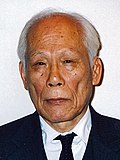 |
Chushiro Hayashi | July 25, 1920 Kyoto, Japan |
February 28, 2010 Kyoto, Japan |
1972 | Nominated the only time by H.Maeda[680] |
| Per-Olov Löwdin | October 28, 1916 Uppsala, Sweden |
October 6, 2000 Uppsala, Sweden |
1972 | Nominated jointly with C.J.(C.)Gorter the only time [681] | |
| Stanley Mandelstam | December 12, 1928 Johannesburg, South Africa |
June 23, 2016 Berkeley, California, United States |
1972 | Nominated jointly with G.F.Chew and M.L.Goldberger the only time by Masao Sugawara (1925-2010) from the Purdue University[682] | |
| Philip McCord Morse | August 6, 1903 Shreveport, Louisiana, United States |
September 5, 1985 Concord, Massachusetts, United States |
1972 | Nominated jointly with Erw.W.Müller the only time by Eugen J. Skudrzyk (1913-1990) from the Penn State[683] | |
| Franco Dino Rasetti | August 10, 1901 Castiglione del Lago, Italy |
December 5, 2001 Waremme, Belgium |
1972 | [684] | |
 |
Léon Charles Prudent Van Hove | February 10, 1924 Brussels, Belgium |
September 2, 1990 Geneva, Switzerland |
1972 | [685] |
| Alan Walsh | December 19, 1916 Hoddlesden, England |
August 3, 1998 Melbourne, Australia |
1972 | Nominated the only time by Robert Street and for the Nobel Prize in Chemistry too[686] | |
 |
Gian Carlo Wick | October 15, 1909 Turin, Kingdom of Italy |
April 20, 1992 Turin, Italy |
1972 | Nominated the only time by Bernard Grossetête (1938-1993) from Orsay[687] |
| Peter Berners Fellgett | April 11, 1922 Ipswich, England |
November 15, 2008 |
1972, 1973 | Nominated jointly with P.Jacquinot only[688] | |
| Ernst Carl Gerlach Stueckelberg | February 1, 1905 Basel, Switzerland |
September 4, 1984 Geneva, Switzerland |
1972, 1974 | [689] | |
| 1973 | |||||
 |
Kenneth Geddes "Ken" Wilson | June 8, 1936 Waltham, Massachusetts, United States |
June 15, 2013 Saco, Maine, United States |
1973, 1974 | Won the 1982 Nobel Prize in Physics[dt][690][691] |
 |
Norman Foster Ramsey Jr. | August 27, 1915 Washington, D.C., United States |
November 4, 2011 Wayland, Massachusetts, United States |
1973 | Shared the 1989 Nobel Prize in Physics[du] with H.G.Dehmelt and W.Paul[692] |
 |
Raymond Davis Jr. | October 14, 1914 Washington, D.C., United States |
May 31, 2006 Blue Point, New York, United States |
1973 | Shared the 2002 Nobel Prize in Physics with M.Koshiba[dv] and R.Giacconi[693] |
 |
Herbert Aaron Hauptman | February 14, 1917 New York City, United States |
October 23, 2011 Buffalo, New York, United States |
1973 | [694] Shared the 1985 Nobel Prize in Chemistry [695] |
 |
Jerome Karle | June 18, 1918 New York, New York, United States |
June 6, 2013 Annandale, Virginia, United States | ||
 |
Isabella Helen Karle (née Lugoski) |
December 2, 1921 Detroit, Michigan, United States |
October 3, 2017 Alexandria, Virginia, United States |
[696] Nominated jointly with J.Karle and H.A.Hauptman the only time by Hans Wondratschek [de] [697] | |
| Michael Mark Woolfson | January 9, 1927 |
December 23, 2019 | |||
 |
Artsimovich, Lev Andreyevich |
February 25, 1909 Moscow, Russian Empire |
March 1, 1973 Moscow, Russian Federation |
1973 | [698] |
 |
James Daniel "BJ" Bjorken | June 22, 1934 Chicago, Illinois, United States |
August 6, 2024 Redwood City, California, United States |
1973 | Nominated the only time by Darrell James Drickey (1934-1974) from UCLA[699] |
 |
Martin Moses Block | November 29, 1925 Newark, New Jersey, United States |
July 22, 2016 Los Angeles, California, United States |
1973 | Nominated jointly with M.Ryle and Abd.Salam the only time[700] |
| Edward Crisp Bullard | September 21, 1907 Norwich, Norfolk, England |
April 3, 1980 La Jolla, California, United States |
1973 | Nominated the only time by Vemu Lakshminarayana Subrahman Bhimasankaram (1931-2021) from the Osmania University[701] | |
| Richard Henry Dalitz | February 28, 1925 Norwich, Dimboola, Australia |
January 13, 2006 Oxford, England, UK |
1973 | Nominated the only time by J.Pniewski[702] | |
| Pierre-Michel Duffieux | February 21, 1891 Saint-Macaire, France |
June 3, 1976 Besançon, France |
1973 | Nominated jointly with P.Jacquinot the only time by Pierre Rouard (1908-1989) from Marseille[703] | |
 |
Ugo Fano | July 28, 1912 Turin, Italy |
February 13, 2001 Chicago, Illinois, United States |
1973 | Nominated jointly with H.Chr.van de Hulst, H.St.W.Massey and K.M.B.Siegbahn the only time by Jacob Kistemaker [de] (1917-2010)[704] |
| Herbert Friedman | June 21, 1916 Brooklyn, New York City, United States |
September 9, 2000 Arlington County, Virginia, United States |
1973 | Nominated jointly with S.Chandrasekhar and N.F.Ramsey Jr. the only time by G.H.Fr.O.J.Herzberg[705] | |
| André Guinier | August 1, 1911 Nancy, France |
July 3, 2000 Paris, France |
1973 | Nominated the only time by Mladen Paic [sl] (1905-1997) and for the Nobel Prize in Chemistry too[706] | |
| Raymond George Herb | January 22, 1908 Navarino, Wisconsin, United States |
October 1, 1996 |
1973 | Nominated the only time by Zdzisław Wilhelmi [pl] (1921-2013)[707] | |
 |
Willibald Jentschke | December 6, 1911 Vienna, Austria-Hungary |
March 11, 2002 Göttingen, Germany |
1973 | Nominated the only time by G.C.Stetter[708] |
| Don Kirkham | February 11, 1908 Provo, Utah, United States |
March 7, 1998 Ames, Iowa, United States |
1973 | Nominated the only time by Daniel Joseph Zaffarano (1917-2004) from the Iowa State[709] | |
| Otto Kratky | March 9, 1902 Vienna, Austria-Hungary |
February 11, 1995 Graz, Austria |
1973 | Nominated for the Nobel Prize in Chemistry too[710] | |
| Michael James Lighthill | January 27, 1924 Paris, France |
July 17, 1998 Sark, Channel Islands |
1973 | Nominated the only time by J."Shôn"E.Ff.Williams[711] | |
| Walter Charles Marshall, Baron Marshall of Goring |
March 5, 1932 Rumney, Cardiff, UK |
February 20, 1996 London, England, UK |
1973 | Nominated the only time by Michael J. Higatsberger [de][712] | |
| Sven Gösta Nilsson | January 14, 1927 Kristianstad, Sweden |
April 24, 1979 Lund, Sweden |
1973 | Nominated jointly with A.N.Bohr and B.R.Mottelson the only time by Willard Lindley Talbert, Jr. (1932-2023) from the Iowa State[713] | |
 |
Karl Raimund Popper | July 28, 1902 Vienna, Austria-Hungary |
September 17, 1994 London, England, UK |
1973 | Nominated the only time by P.Cl.Thonemann[714] |
| Ronald Samuel Rivlin | May 6, 1915 London, England, UK |
October 4, 2005 Palo Alto, California, United States |
1973 | Nominated the only time by A.J.M.Spencer[715] | |
 |
John Shipley Rowlinson | May 12, 1926 Handforth, Cheshire, England, UK |
August 15, 2018 Palo Alto, California, United States |
1973 | Nominated jointly with R.Kubo and Il.R.Prigogine the only time by Friedrich Kohler (1924–2007) from the University of Vienna[716] |
 |
Wojciech Sylwester Piotr Rubinowicz | February 22, 1889 Sadagóra, Bukovina, Austro-Hungarian Empire |
October 13, 1974 Warsaw, Poland |
1973 | Nominated jointly with Ali Javan the only time[717] |
| Samuel Tolansky (born Turlausky) |
November 17, 1906 Newcastle-upon-Tyne, England, UK |
March 4, 1973 |
1973 | Nominated the only time by Ernest Hirschlaff Hutten [de] (1908-1996)[718] | |
| Harry Lehmann | March 21, 1924 Güstrow, Germany |
November 22, 1998 Hamburg, Germany |
1973 | [719] Jointly[720] nominated only [721] [722] | |
| Kurt Symanzik | November 21, 1923 Lyck, East Prussia, Germany |
October 25, 1983 Hamburg, Germany | |||
| Wolfhart Zimmermann | February 17, 1928 Freiburg im Breisgau, Germany |
September 18, 2016 Hamburg, Germany | |||
| Phyllis St. Freier (née Cyr) |
January 19 (or 21), 1921 Minneapolis, Minnesota, United States |
December 18, 1992 St. Paul, Minnesota, United States |
1973 | [723] [724] Jointly[725] nominated the only time by W.Fr.Libby [726] [727] | |
 |
Edward Purdy Ney | October 28, 1920 Minneapolis, Minnesota, United States |
July 9, 1996 Minneapolis, Minnesota, United States | ||
| Edward Joseph Lofgren | January 18, 1914 Chicago, Illinois, United States |
September 6, 2016 | |||
 |
Frank Friedman Oppenheimer | August 14, 1912 New York City, United States |
February 3, 1985 Sausalito, California, United States | ||
| 1974 | |||||
 |
Leo James Rainwater | December 9, 1917 Council, Idaho, United States |
May 31, 1986 New York City, United States |
1974 | Shared the 1975 Nobel Prize in Physics[cj] with A.N.Bohr and B.R.Mottelson[728] |
 |
Steven Weinberg | May 3, 1933 New York City, United States |
July 23, 2021 Austin, Texas, United States |
1974 | Shared the 1979 Nobel Prize in Physics[ca] with M.Abd.Salam and Sh.L.Glashow[729] |
 |
Peter Dennis Mitchell | September 29, 1920 Mitcham, Surrey, England |
April 10, 1992 Bodmin, Cornwall, England |
1974 | Won the 1978 Nobel Prize in Chemistry[730] |
 |
Walter Kohn | March 9, 1923 Vienna, Austria |
April 19, 2016 Santa Barbara, California, United States |
1974 | Won the 1998 Nobel Prize in Chemistry[731] |
 |
Manfred von Ardenne | January 20, 1907 Hamburg, Germany |
May 26, 1997 Dresden, Saxony, Germany |
1974 | Nominated jointly with Erw.W.Müller and E.A.Fr.Ruska the only time by Frans Erik Wickman (1915–2003) from the Penn State[732] |
| David Robert Bates | November 18, 1916 Omagh, County Tyrone, Northern Ireland, UK |
January 5, 1994 Belfast, Northern Ireland, UK |
1974 | Nominated jointly with H.St.W.Massey the only time by Jean-Claude Pebay-Peyroula (1930–2011) from the Joseph Fourier University, Grenoble[733] | |
| Herbert P. Broida [de] | December 25, 1920 Aurora, Colorado, United States |
April 9, 1978 Santa Barbara, California, United States |
1974 | Nominated the only time[734] | |
| Paul Glansdorff [de] | October 17, 1904 Saint-Gilles, Belgium |
June 23, 1999 Uccle, Belgium |
1974 | Nominated jointly with Il.R.Prigogine the only time by Noël Felici [fr] (1916-2010)[735] | |
| Erwin Louis Hahn | June 9, 1921 Sharon, Pennsylvania, United States |
September 20, 2016 Berkeley, California, United States |
1974 | Nominated jointly with J.H.Van Vleck the only time by Luigi Giulotto [it] (1911-1986)[736] | |
| Vernon Willard Hughes | May 28, 1921 Kankakee, Illinois, United States |
March 25, 2003 |
1974 | Nominated jointly with M.Deutsch the only time by A.Kastler[737] | |
 |
Kjell Johnsen [de] | June 11, 1921 Meland, Norway |
July 18, 2007 La Rippe, Switzerland |
1974 | Nominated the only time by Bernard Grossetête (1938-1993) from Orsay[738] |
 |
Leo Philip Kadanoff | January 14, 1937 New York City, United States |
October 26, 2015 Chicago, Illinois, United States |
1974 | Nominated jointly with E.C.G.Stueckelberg and K.G."Ken" Wilson the only time by Ch.P.Enz[739] |
| José Leite Lopes | October 28, 1918 Recife, Pernambuco, Brazil |
June 12, 2006 Rio de Janeiro, Brazil |
1974 | Nominated the only time by O.B.Klein[740] | |
| Chia-Chiao Lin | July 7, 1916 Beijing, China |
January 13, 2013 Beijing, China |
1974 | Nominated jointly with J.H.Oort the only time by L.Biermann[741] | |
 |
Heinz Maier-Leibnitz | March 28, 1911 Esslingen am Neckar, Germany |
December 16, 2000 Allensbach, Germany |
1974 | Nominated the only time[742] |
 |
Robert Gaston André Maréchal | December 10, 1916 La Garenne-Colombes, France |
October 14, 2007 17e arrondissement de Paris, France |
1974 | Nominated jointly with M.Françon the only time by Jean Barraud (1911-) from Université Paris 7[743] |
 |
Kadomtsev, Boris Borisovich |
November 9, 1928 Jarkent, Russian Empire |
August 19, 1998 Moscow, Russian Federation |
1974 | Nominated jointly with M.N.Rosenbluth the only time by Cornelis Marius “Kees” Braams (1925-2003) from the Utrecht University[744] |
 |
Marshall Nicholas Rosenbluth | February 5, 1927 Albany, New York, United States |
September 28, 2003 San Diego, California, United States |
1974 | [745] |
| Саранцев, Владислав Павлович [ru] | September 23, 1930 Saratov, Russian Empire |
January 31, 1995 Moscow, Russian Federation |
1974 | Nominated the only time by Ivan Štoll [cs](1935–2017)[746] | |
| Lincoln Wolfenstein | February 10, 1923 Cleveland, Ohio, United States |
March 27, 2015 Oakland, California, United States |
1974 | Nominated jointly with J.W.Cronin and V.L.Fitch the only time by G.Marx[747] | |
 |
Ralph Asher Alpher | February 3, 1921 Washington, D.C., United States |
August 12, 2007 Austin, Texas, United States |
1974 | [748] Jointly[749] nominated the only time by R.Hofstadter [750] |
| Robert Herman | August 29, 1914 Bronx, New York City, United States |
February 13, 1997 Austin, Texas, United States | |||
 |
John Adam Presper "Pres" Eckert Jr. | April 9, 1919 Philadelphia, Pennsylvania, United States |
June 3, 1995 Bryn Mawr, Pennsylvania, United States |
1974 | [751] Jointly[752] nominated the only time by J.T.Wallmark [753] |
 |
John William Mauchly | August 30, 1907 Cincinnati, Ohio, United States |
January 8, 1980 Ambler, Pennsylvania, United States | ||
 |
Robert Eugene Marshak | October 11, 1916 Bronx, New York City, United States |
December 23, 1992 Cancún, Mexico |
1974 | [754] Nominated jointly with M.A.Salam the only time by Jan S. Nilsson [sv] (1932-2010) [755] |
 |
Ennackal Chandy George Sudarshan | September 16, 1931 Pallom, Travancore, British India |
May 13, 2018 Austin, Texas, United States | ||
| 1975 | |||||
| Nominees are usually published 50 years later (2025),[756] so 1975 nominees should be published at 2026. | |||||
| 1975 | |||||
Close
Remove ads
See also
- List of Nobel laureates in Physics
- List of female nominees for the Nobel Prize
- List of nominees for the Nobel Prize in Chemistry
- List of nominees for the Nobel Prize in Physiology or Medicine
- List of nominees for the Nobel Prize in Literature
- List of individuals nominated for the Nobel Peace Prize
- List of organizations nominated for the Nobel Peace Prize
Motivations and remarks
- Nominations were declared invalid by the Nobel Committee – The Nobel Population 1901–1937: A Census of the Nominators and Nominees for the Prizes in Physics and Chemistry Elisabeth T. Crawford, J. L. Heilbron, Rebecca Ullrich (Office for History of Science and Technology, University of California, 1987)
- Nevertheless most probable nominee is Jules Richard (1848–1930) – inventor of a few meteorological instruments (including aneroid barograph)
- French physicist Alexandre Henri Georges Dauvillier (5 May 1892 Saint-Lubin-des-Joncherets – 23 September 1979 Bagnères-de-Bigorre) from Paris
- “All nominations with Br.Josephson have been hidden at the Nomination Archive site according to § 8 of the statutes governing the Nobel archives of the Royal Swedish Academy of Sciences”
- Osmund Dorenfeldt Jenssen (1923–2009) from the University of Trondheim
- “Nomination 20866 to J.Bell has been hidden at the Nomination Archive site according to § 8 of the statutes governing the Nobel archives of the Royal Swedish Academy of Sciences”
- “Nomination 20810 (with Br.Josephson) has been hidden at the Nomination Archive site according to § 8 of the statutes governing the Nobel archives of the Royal Swedish Academy of Sciences”
Remove ads
References
Wikiwand - on
Seamless Wikipedia browsing. On steroids.
Remove ads
Remove ads
